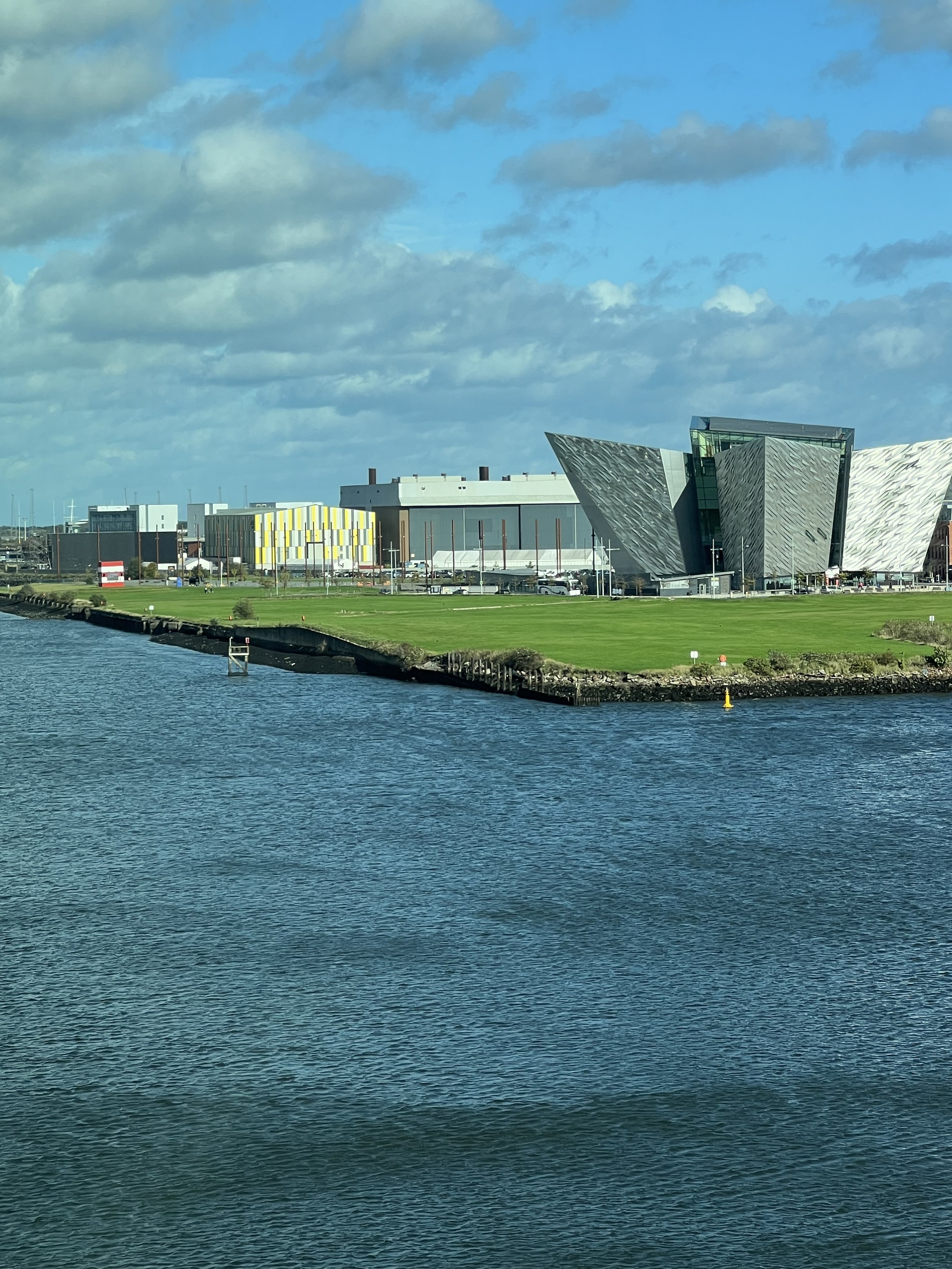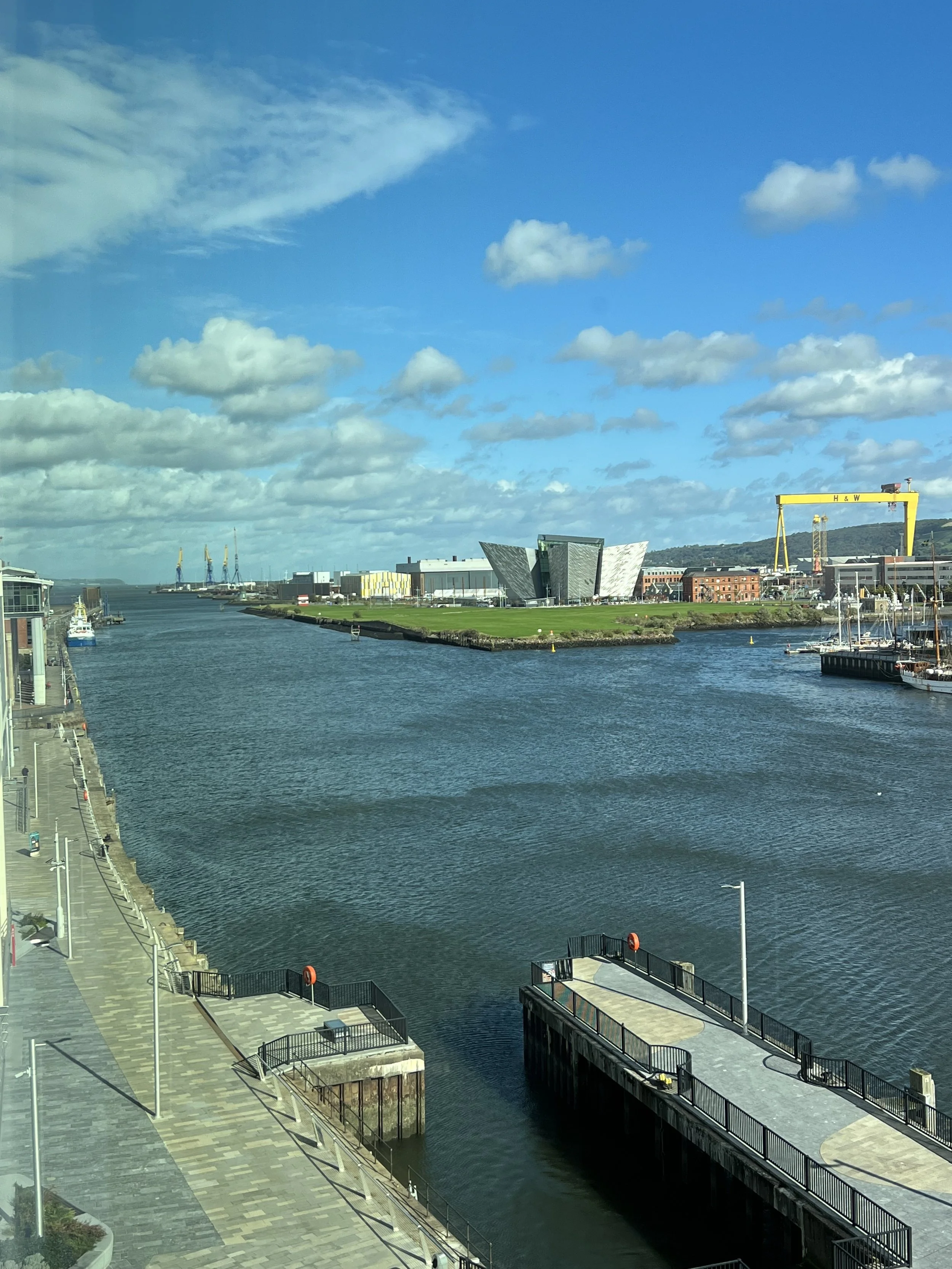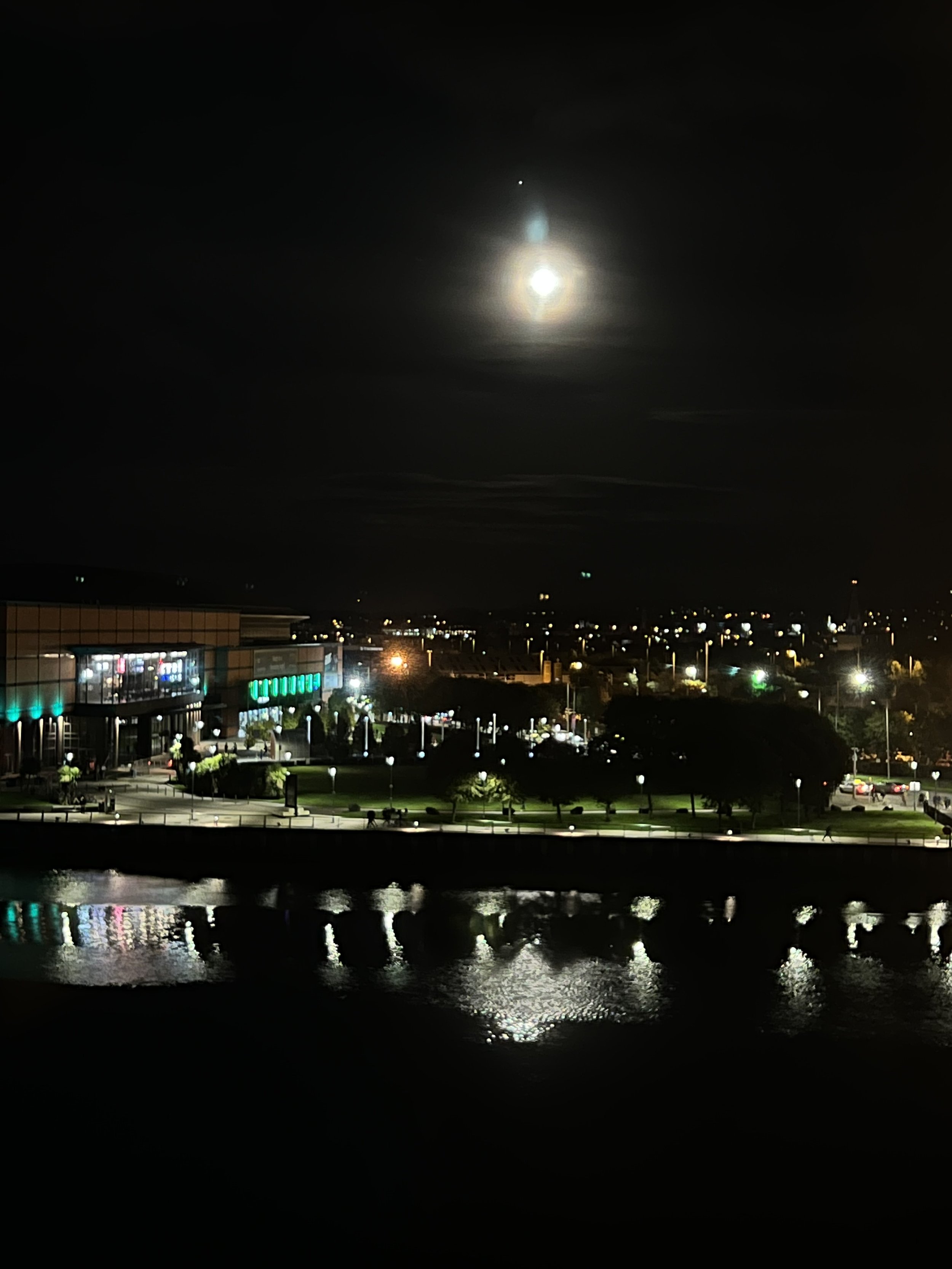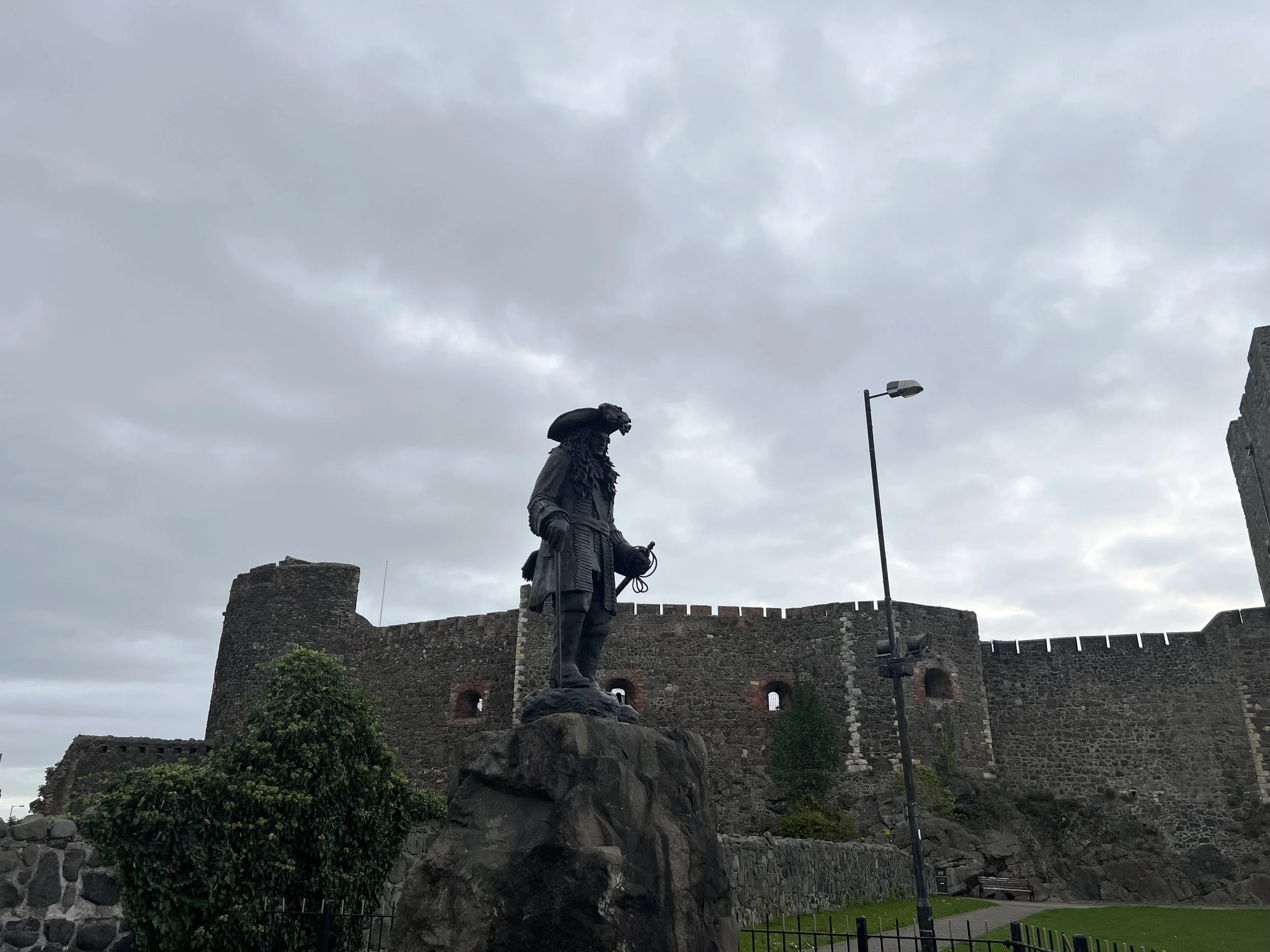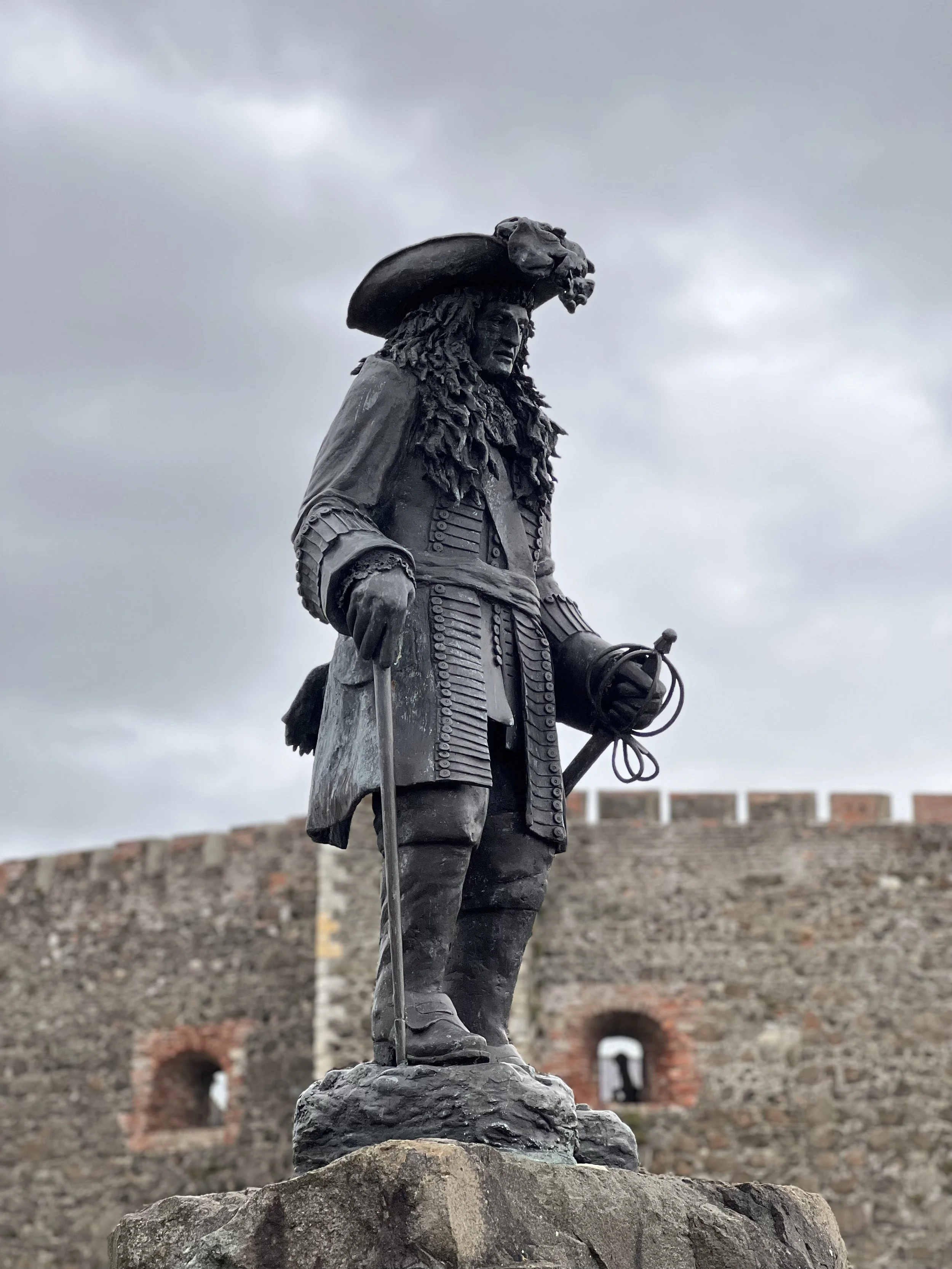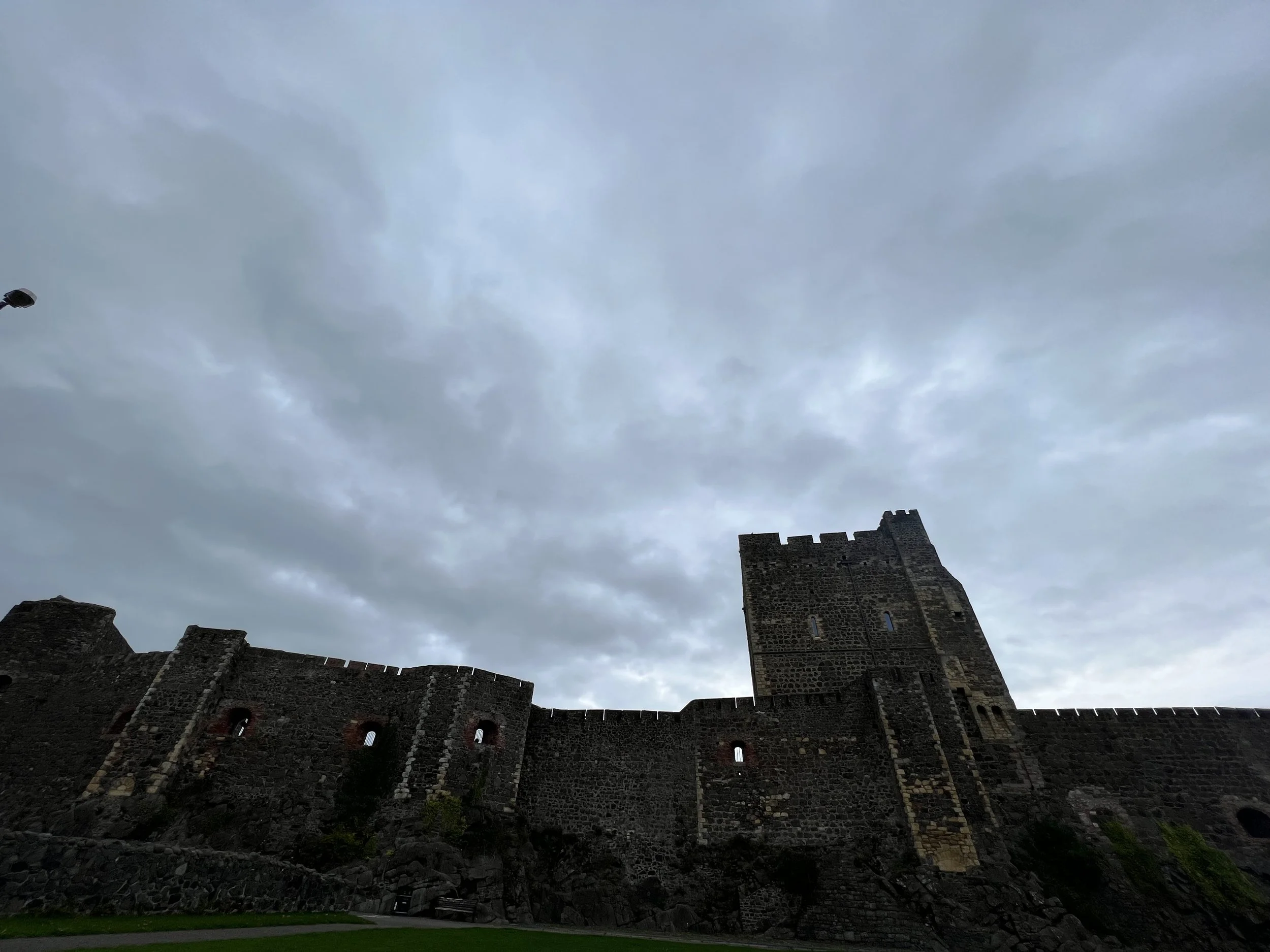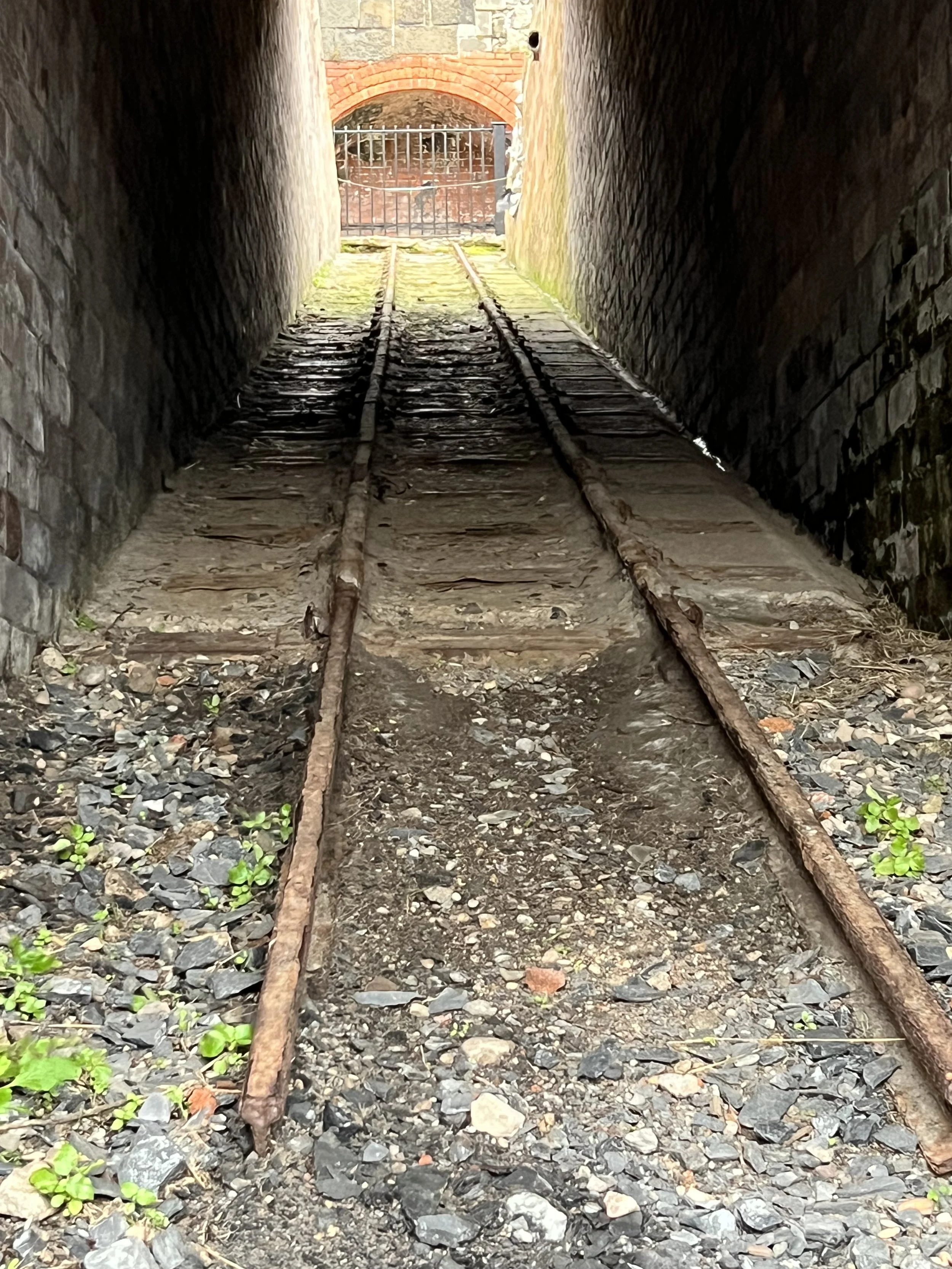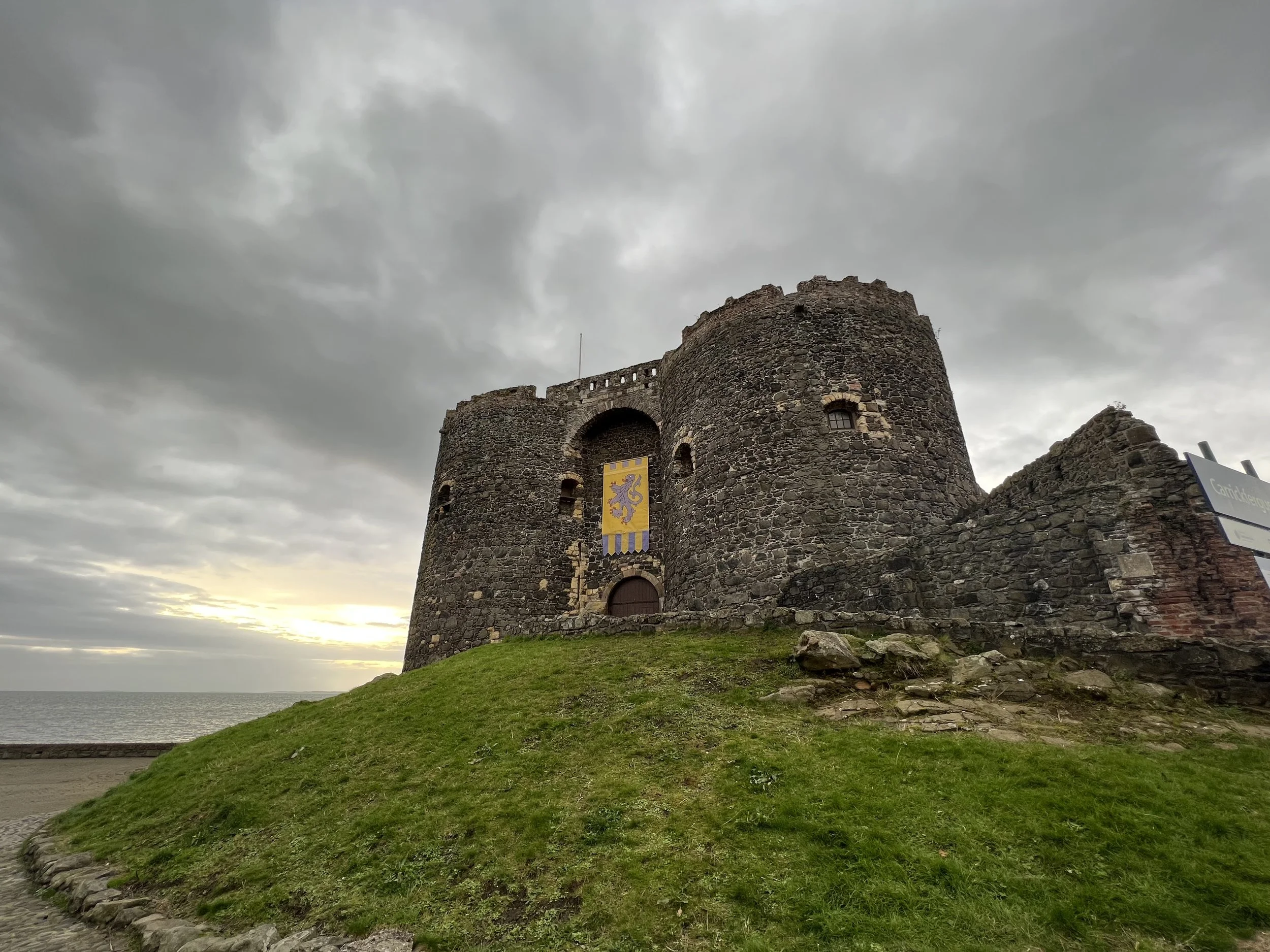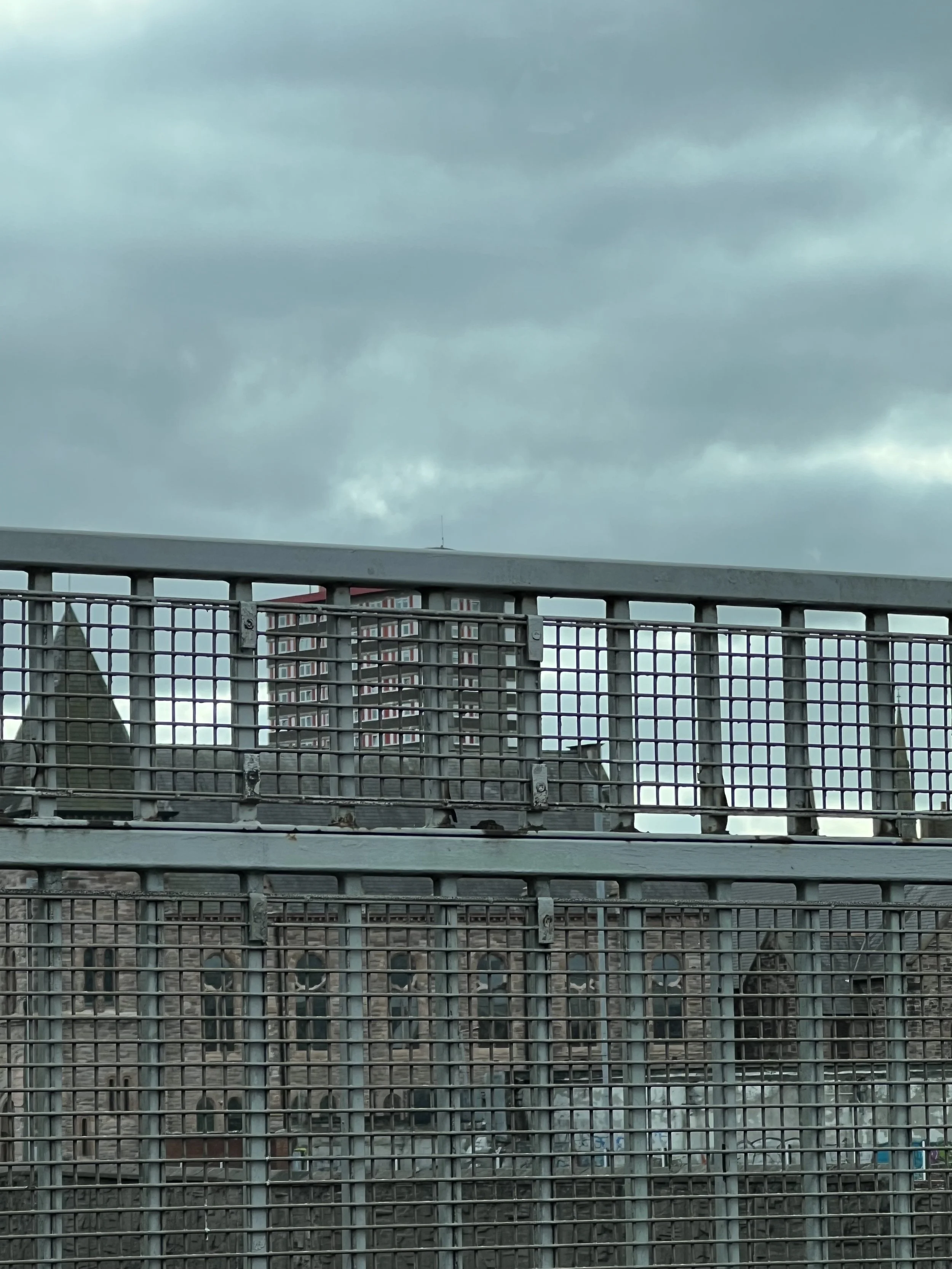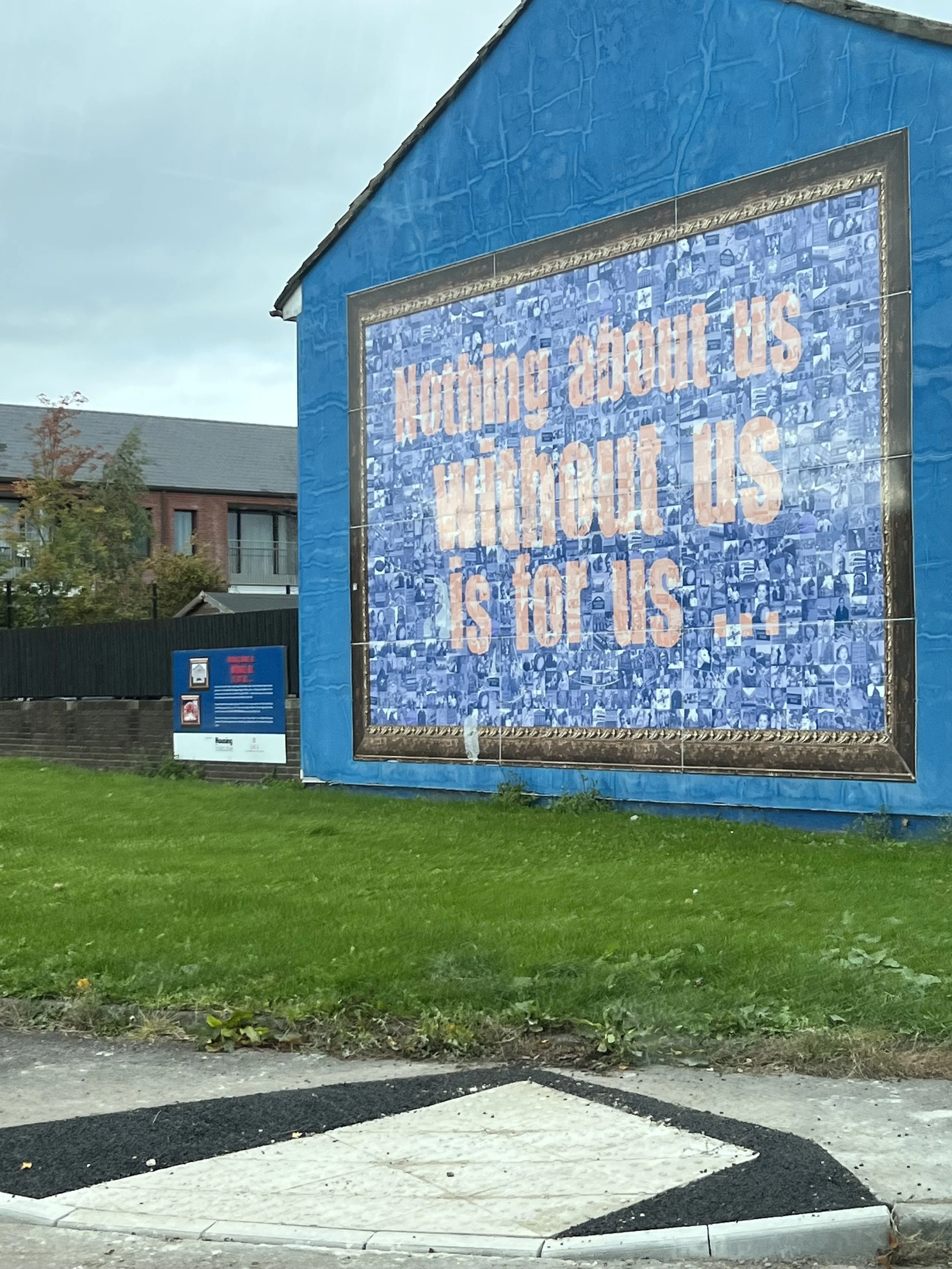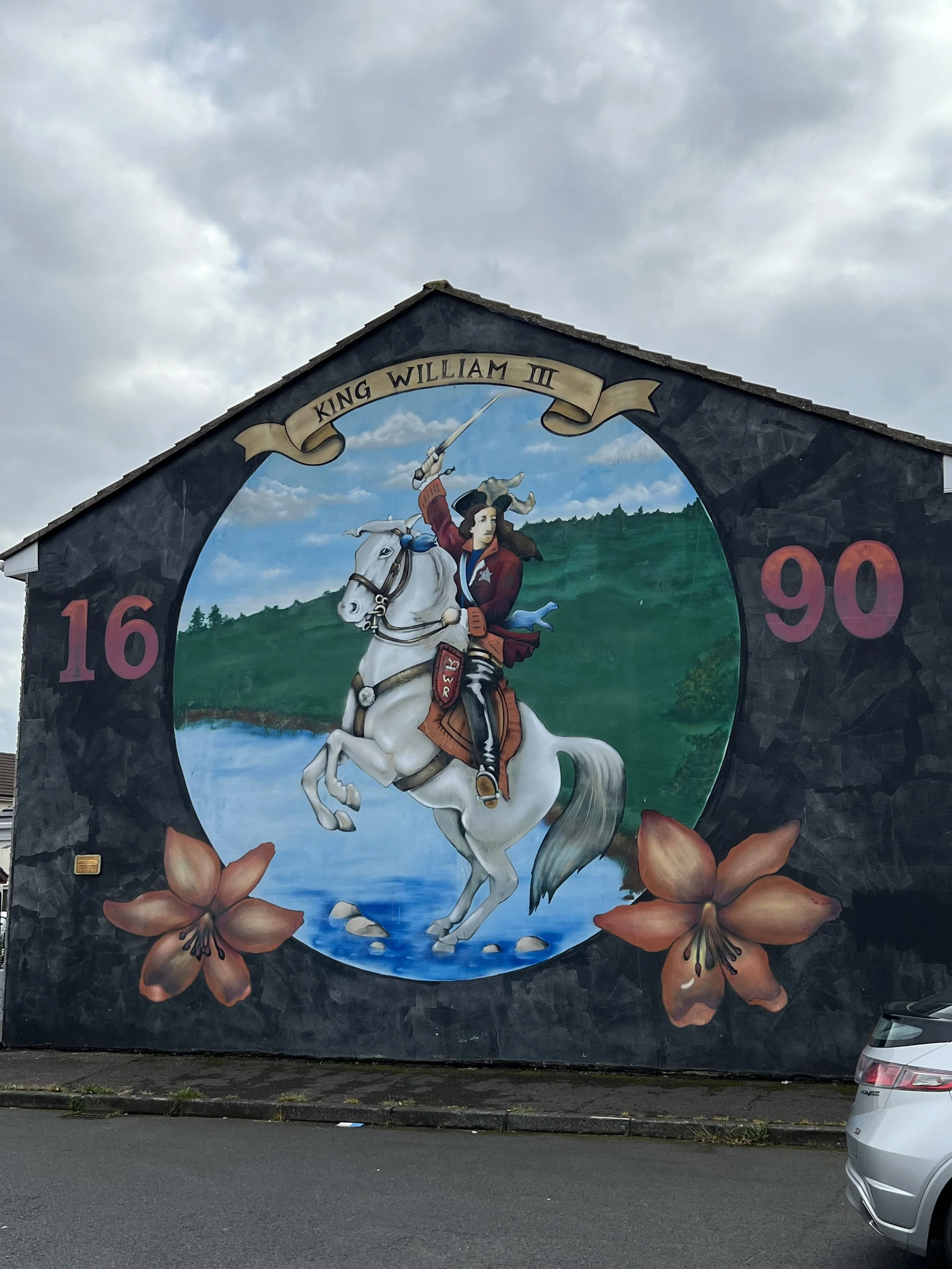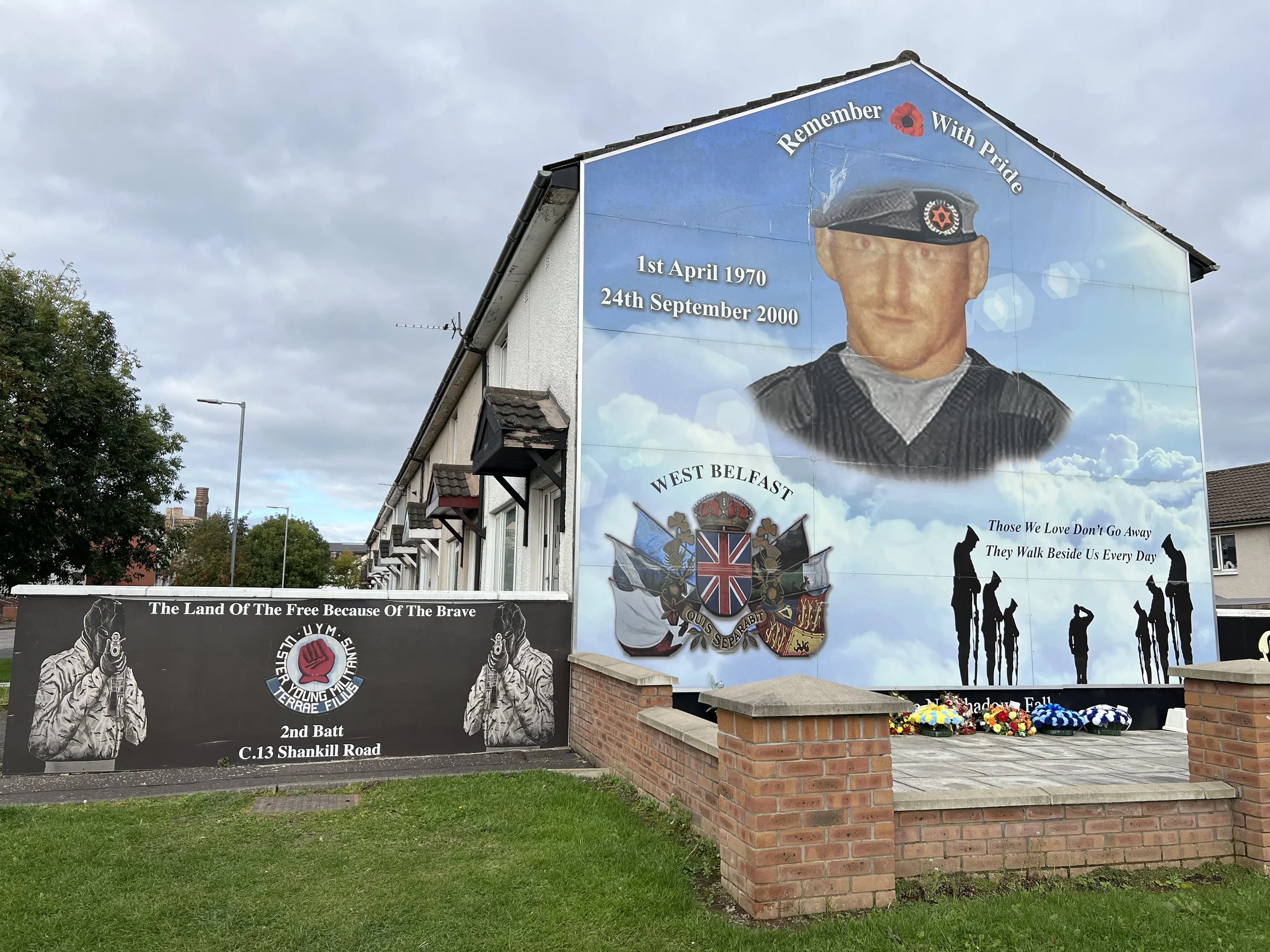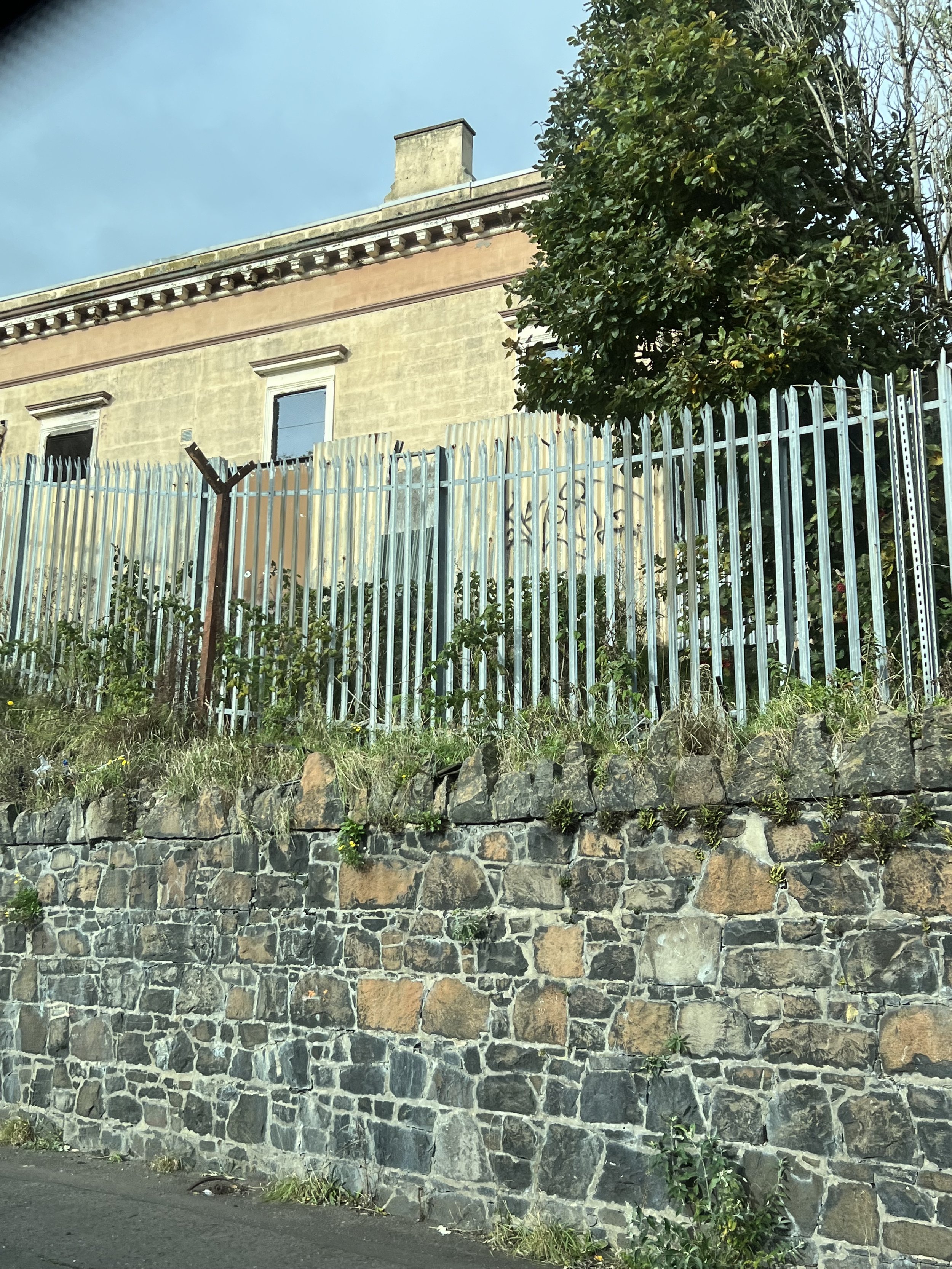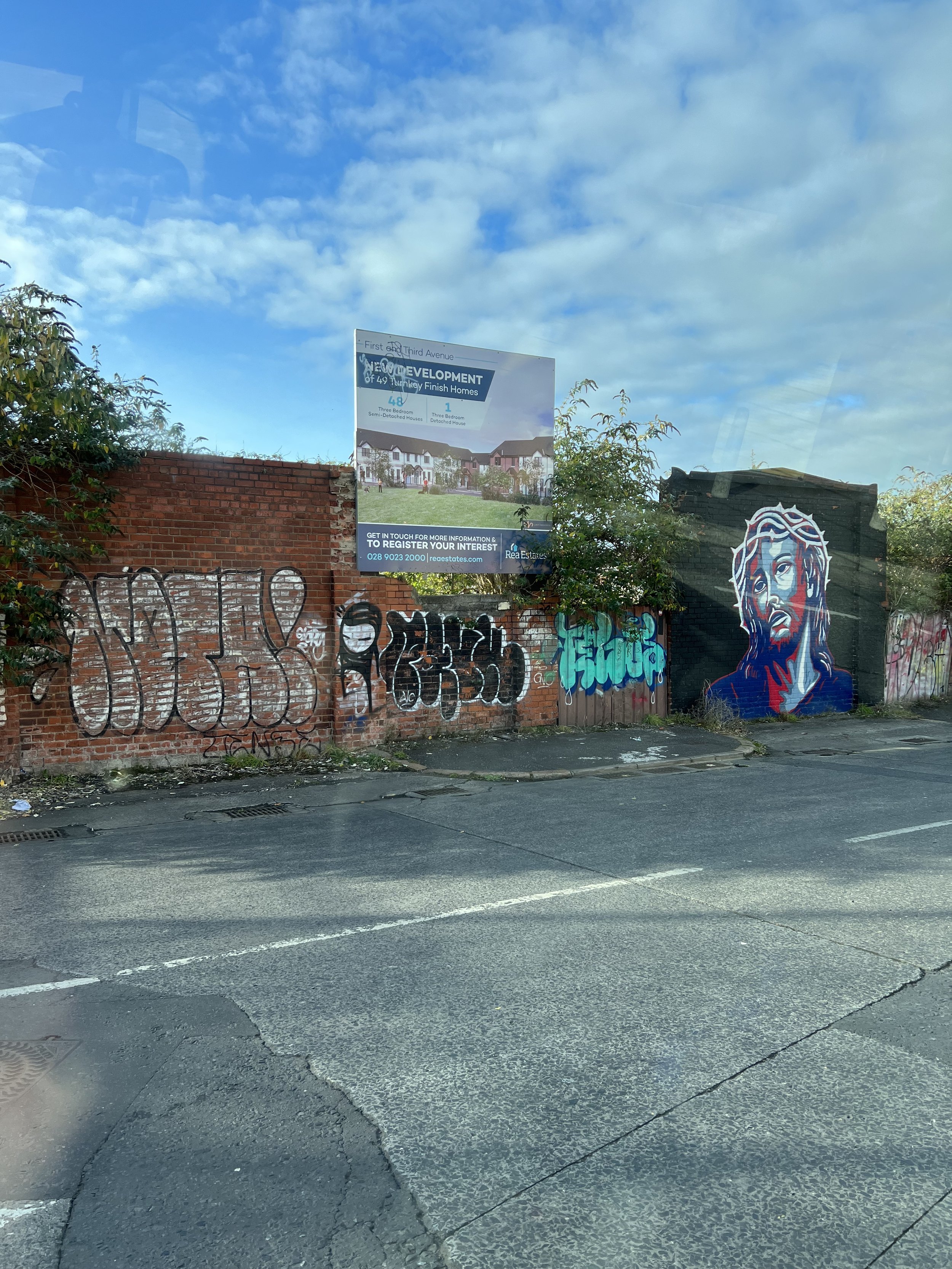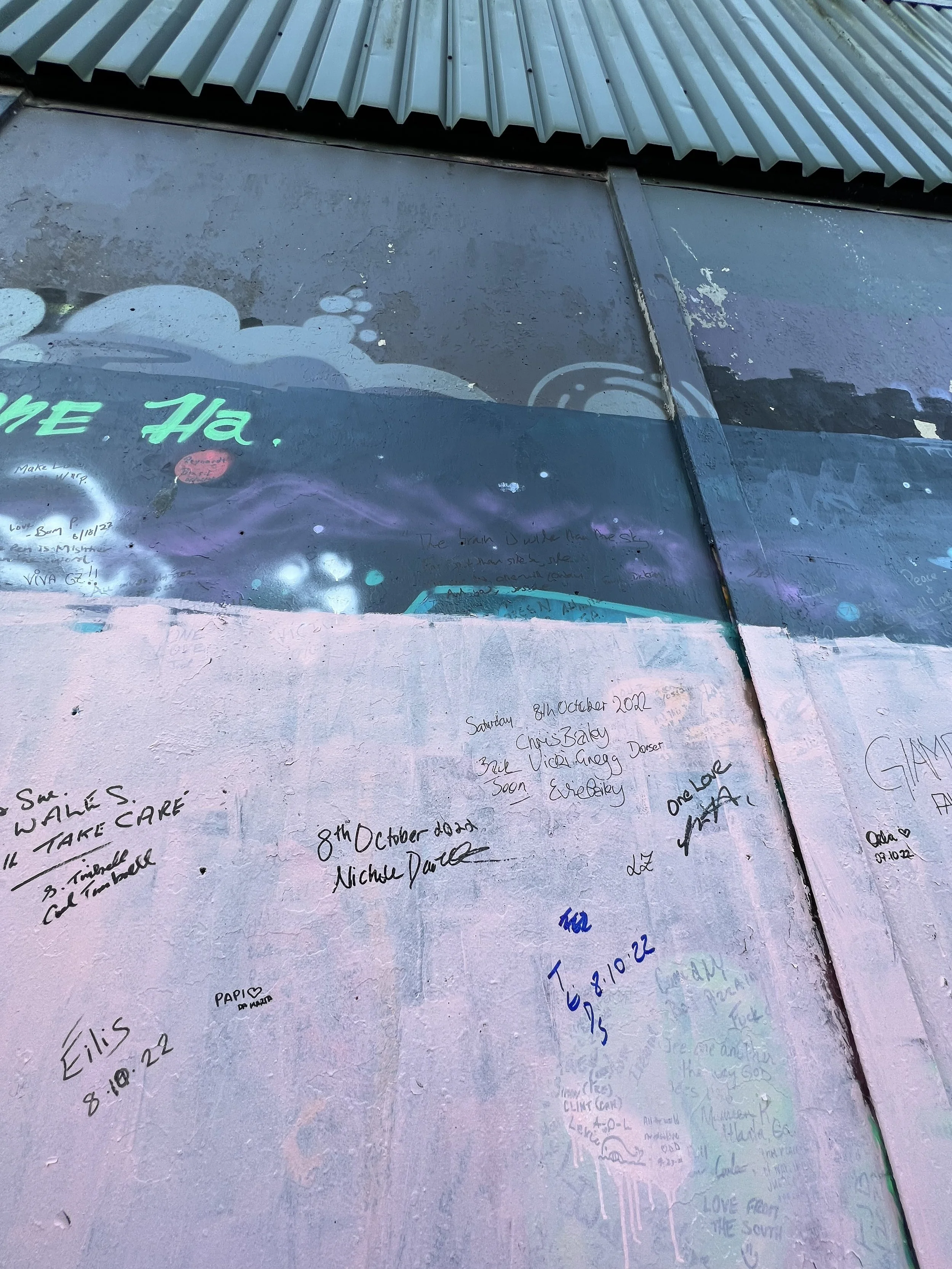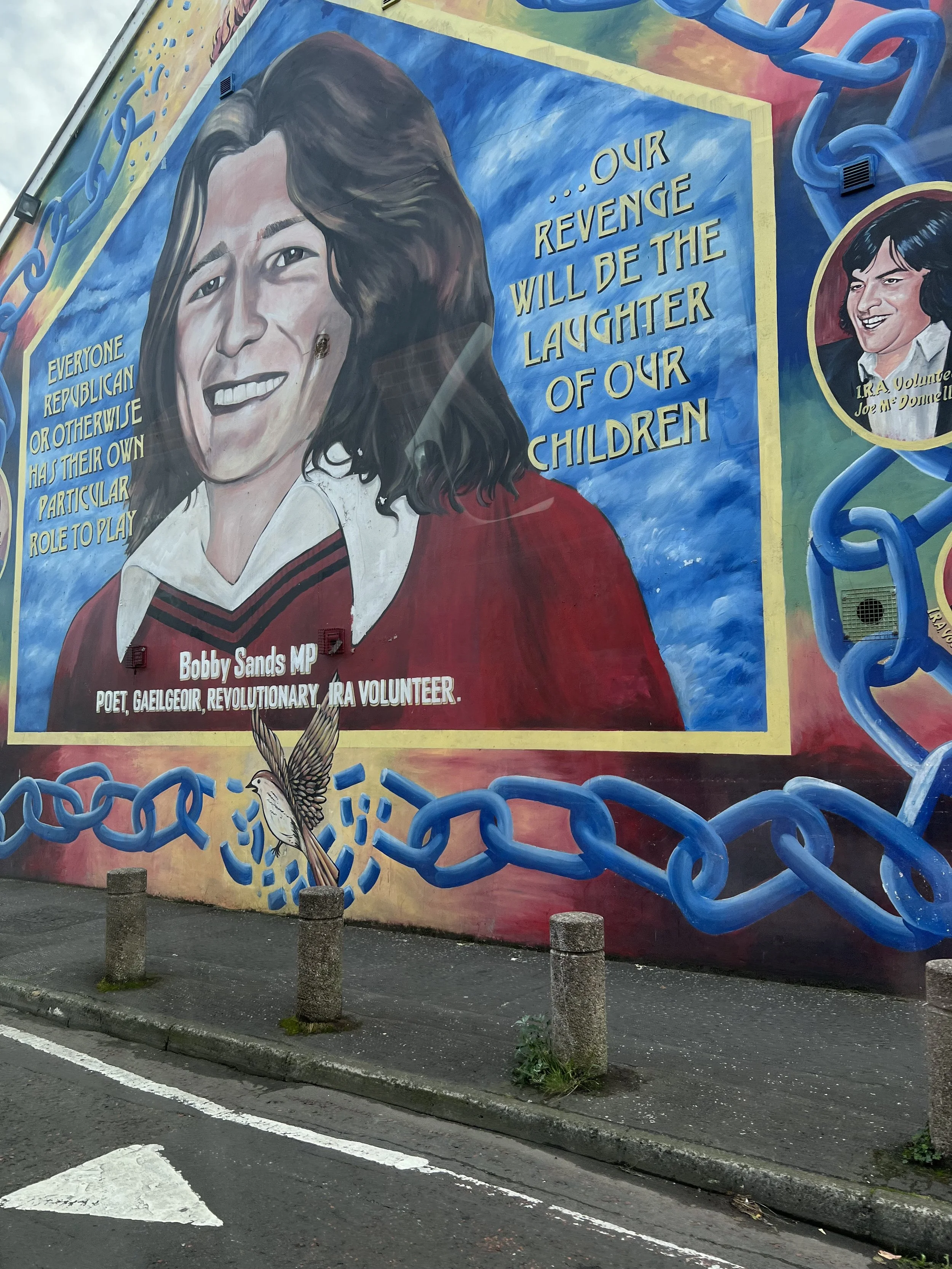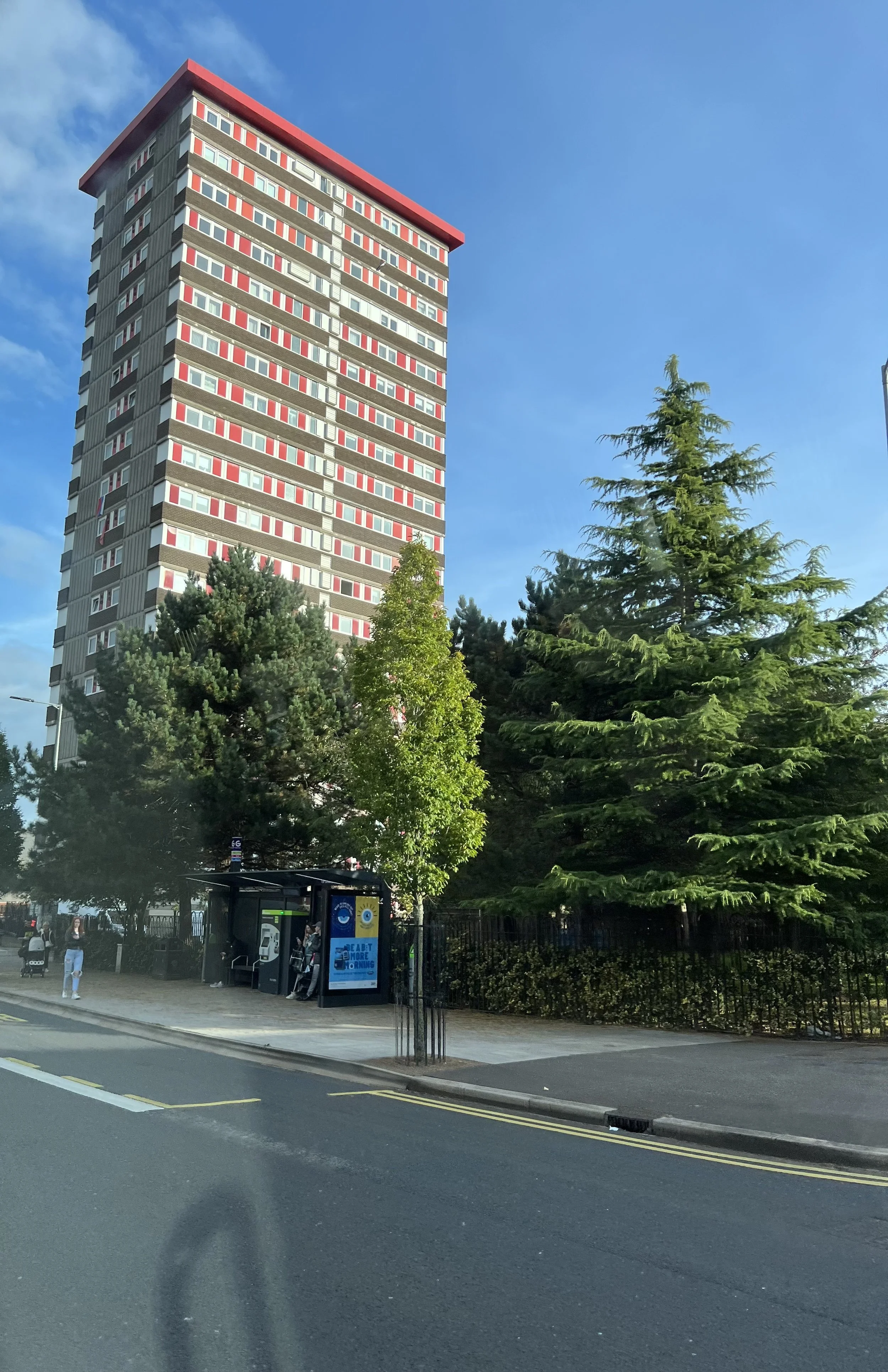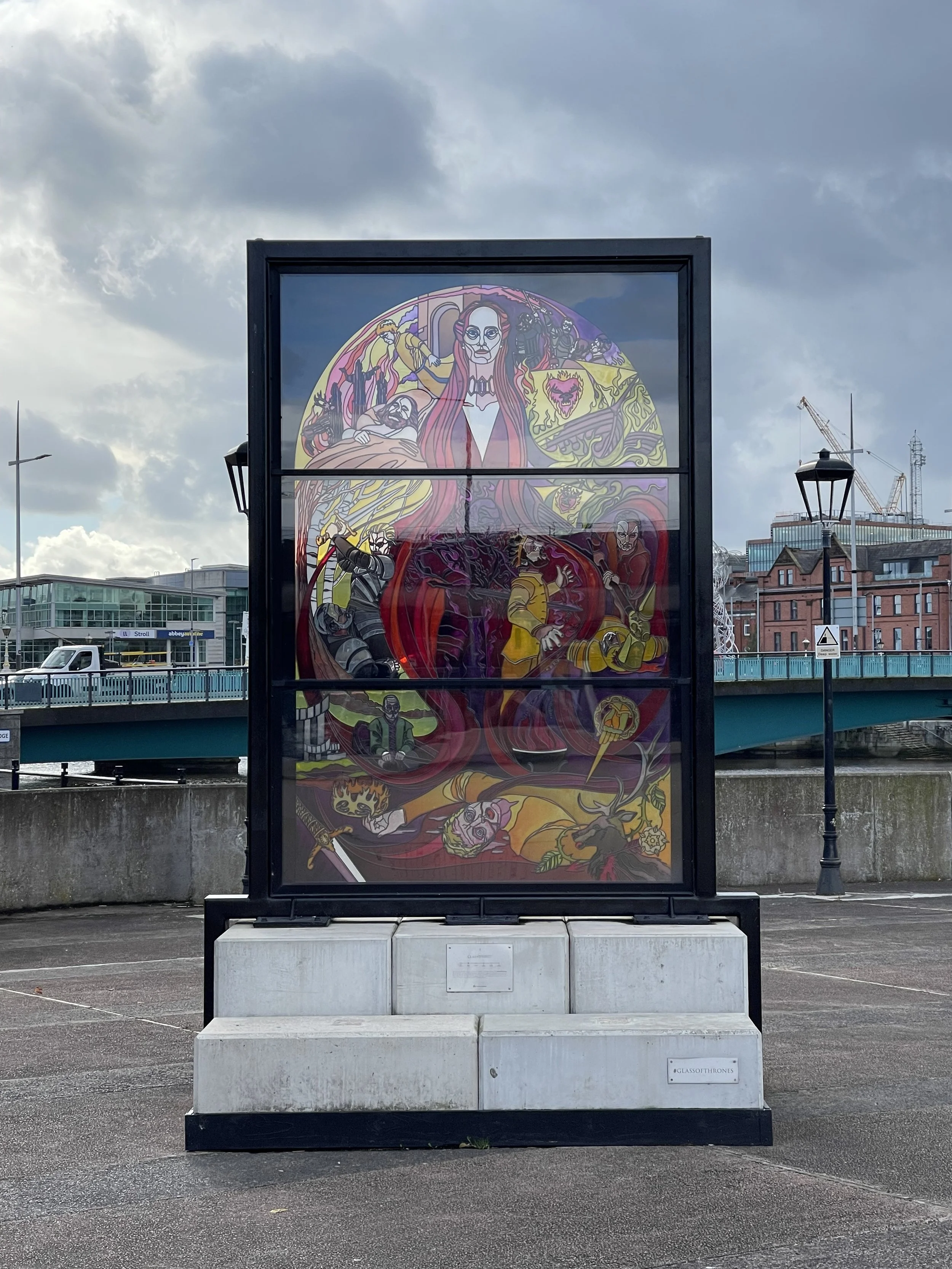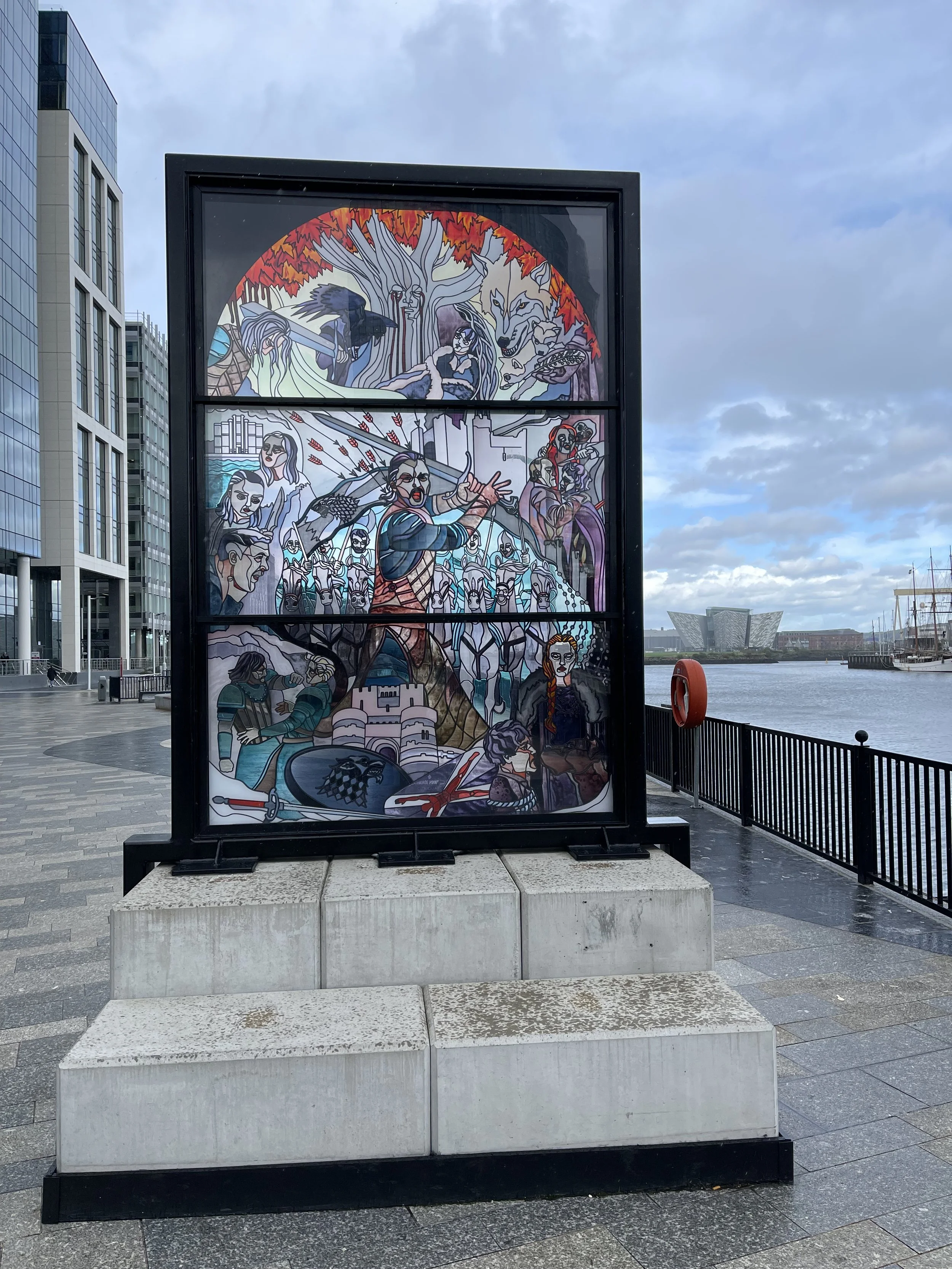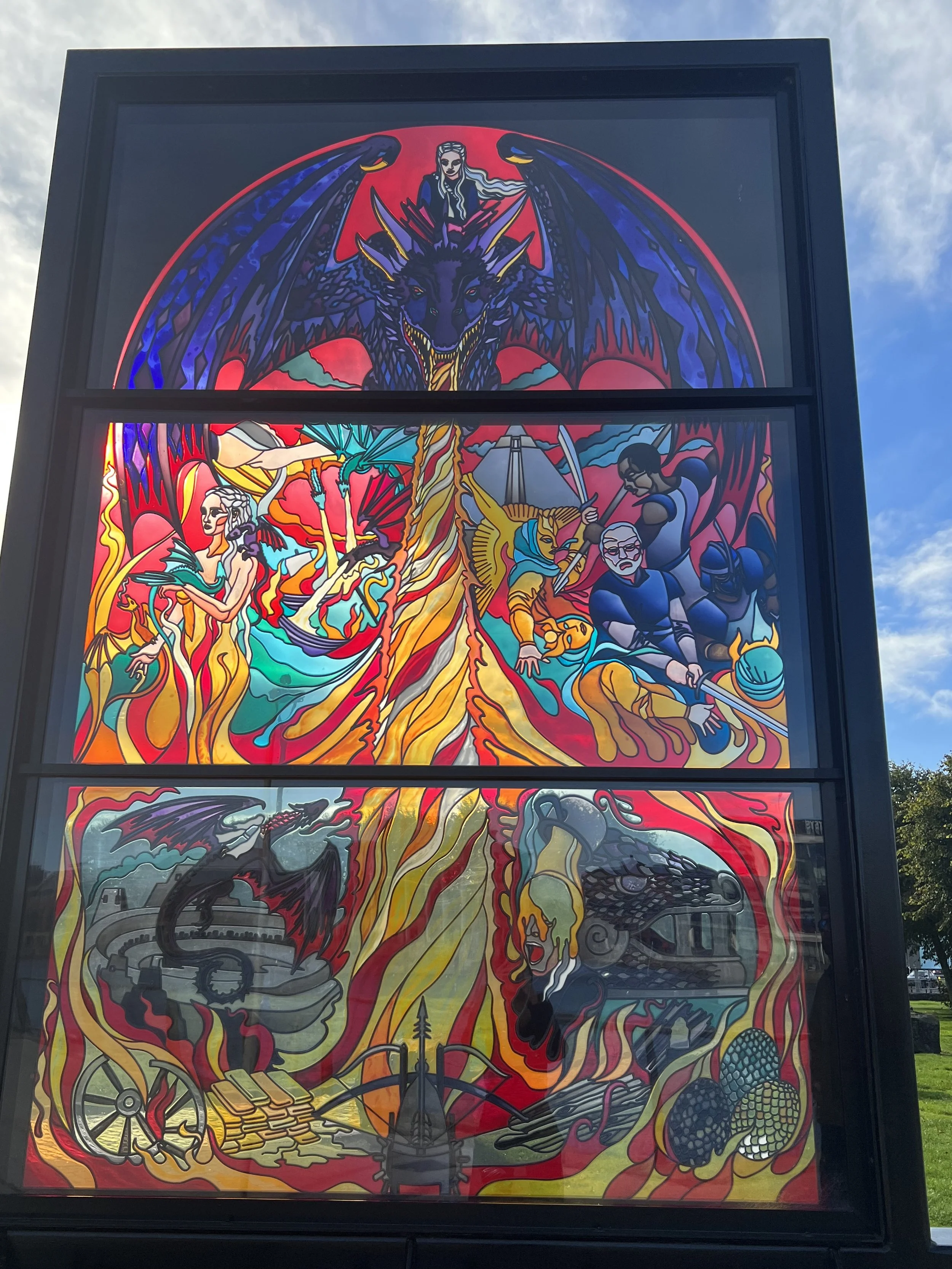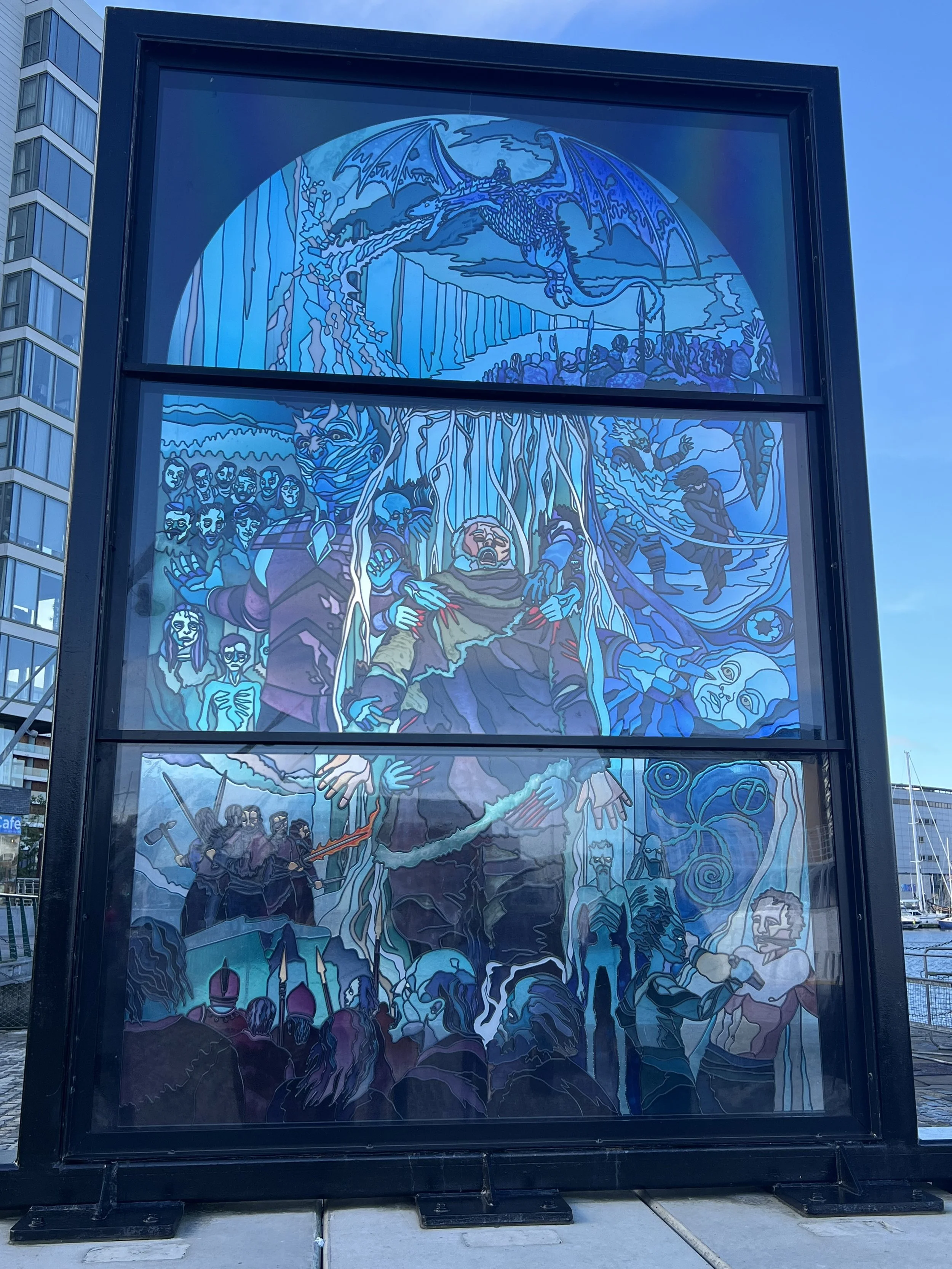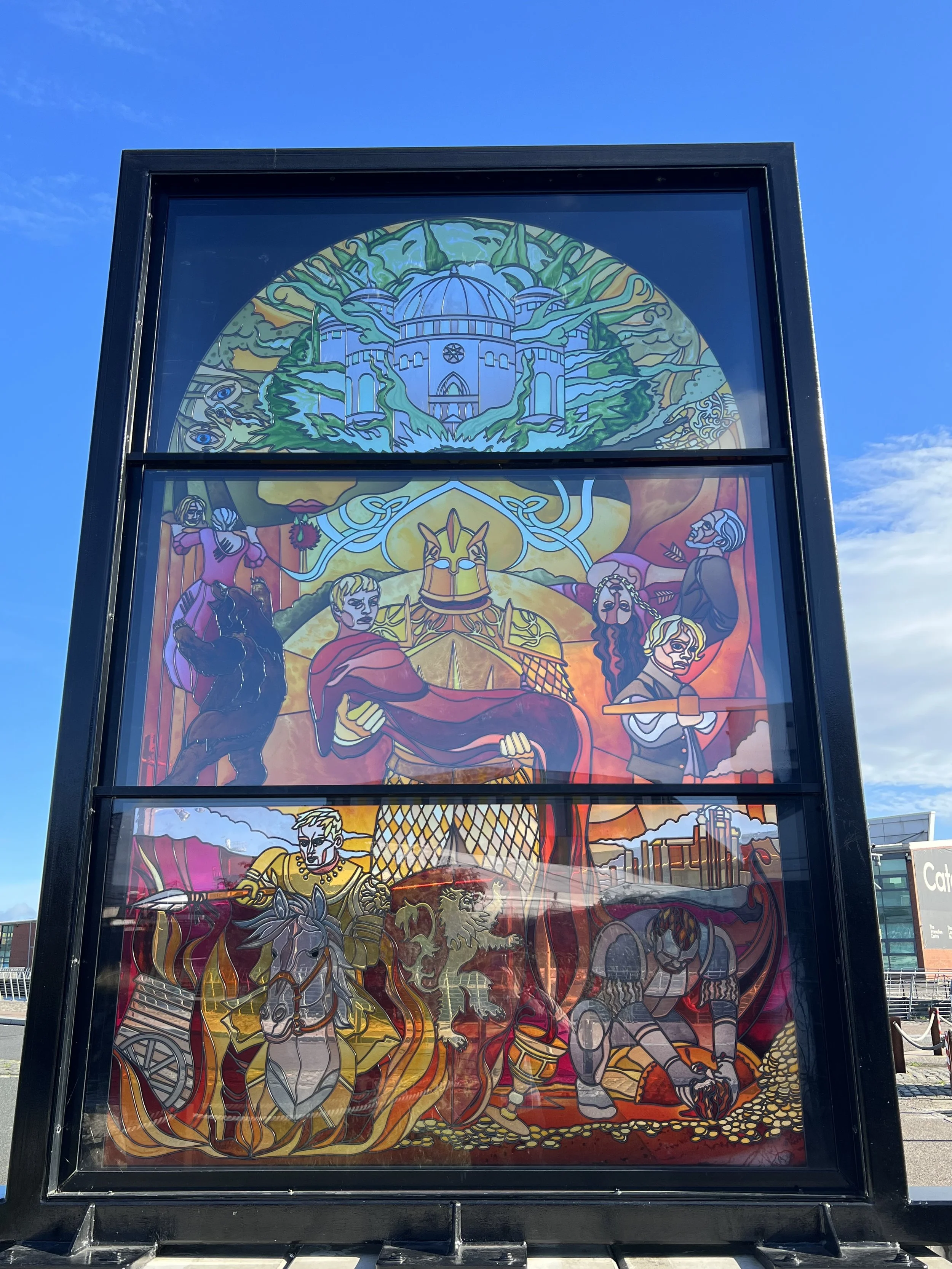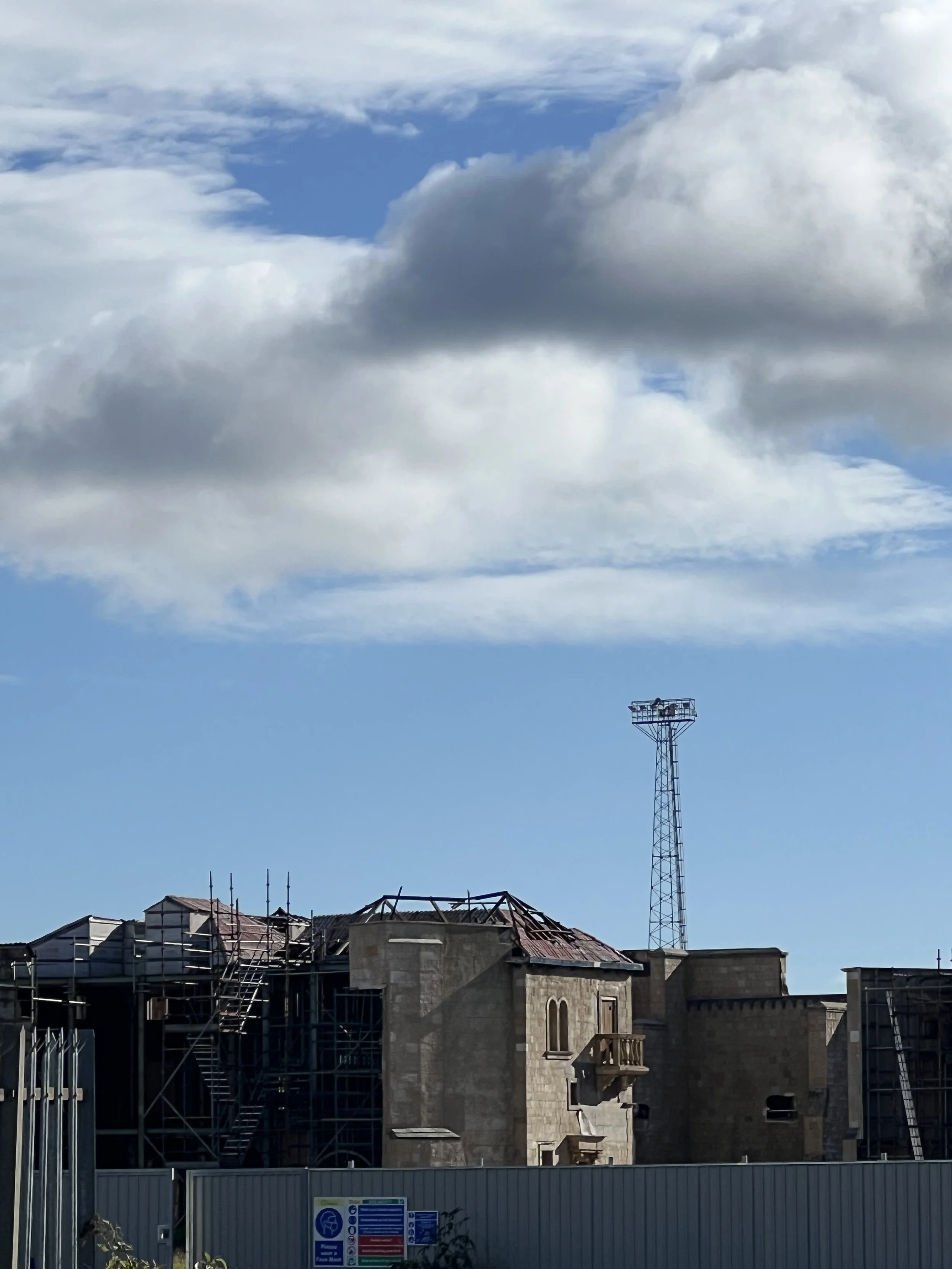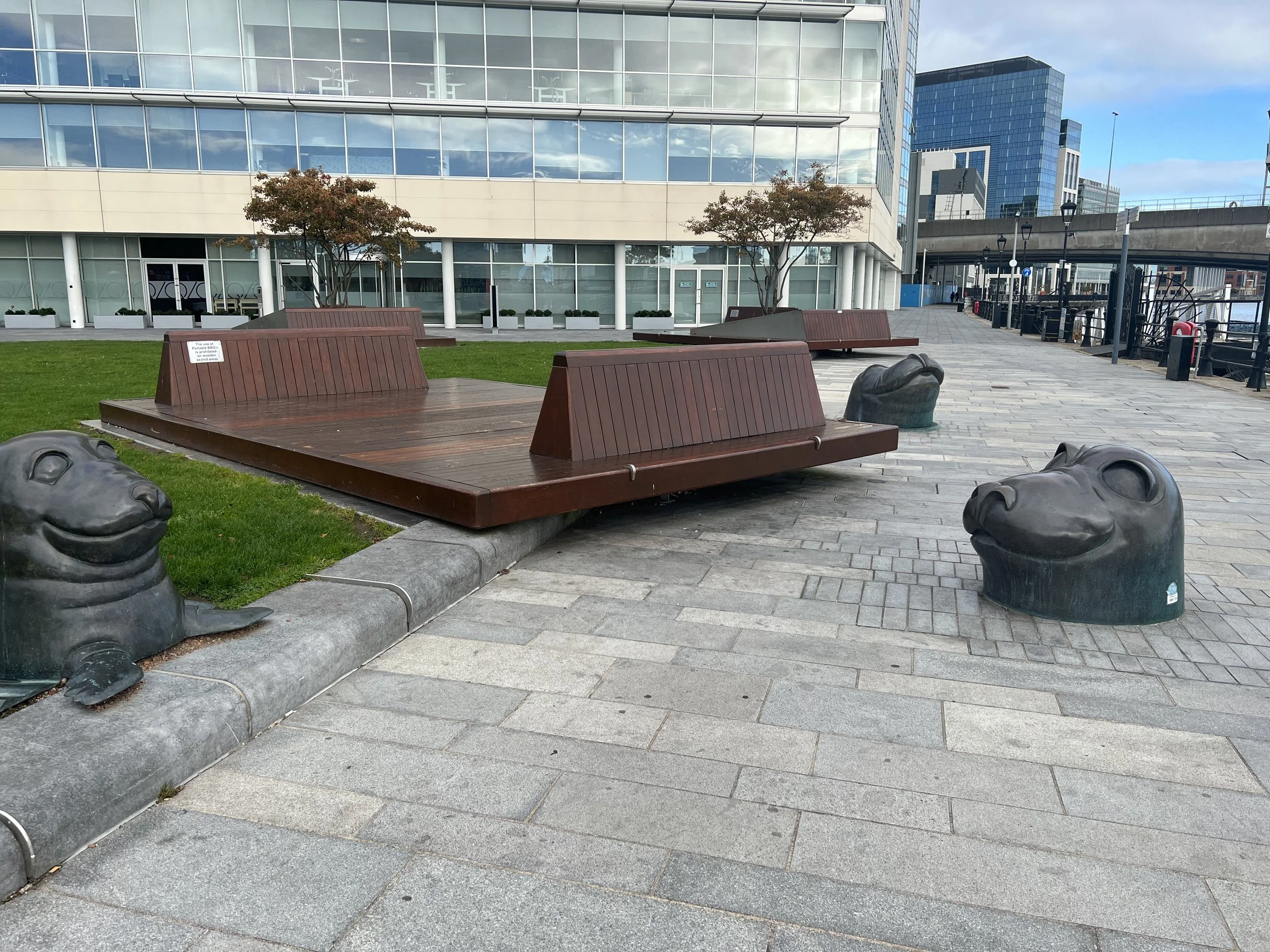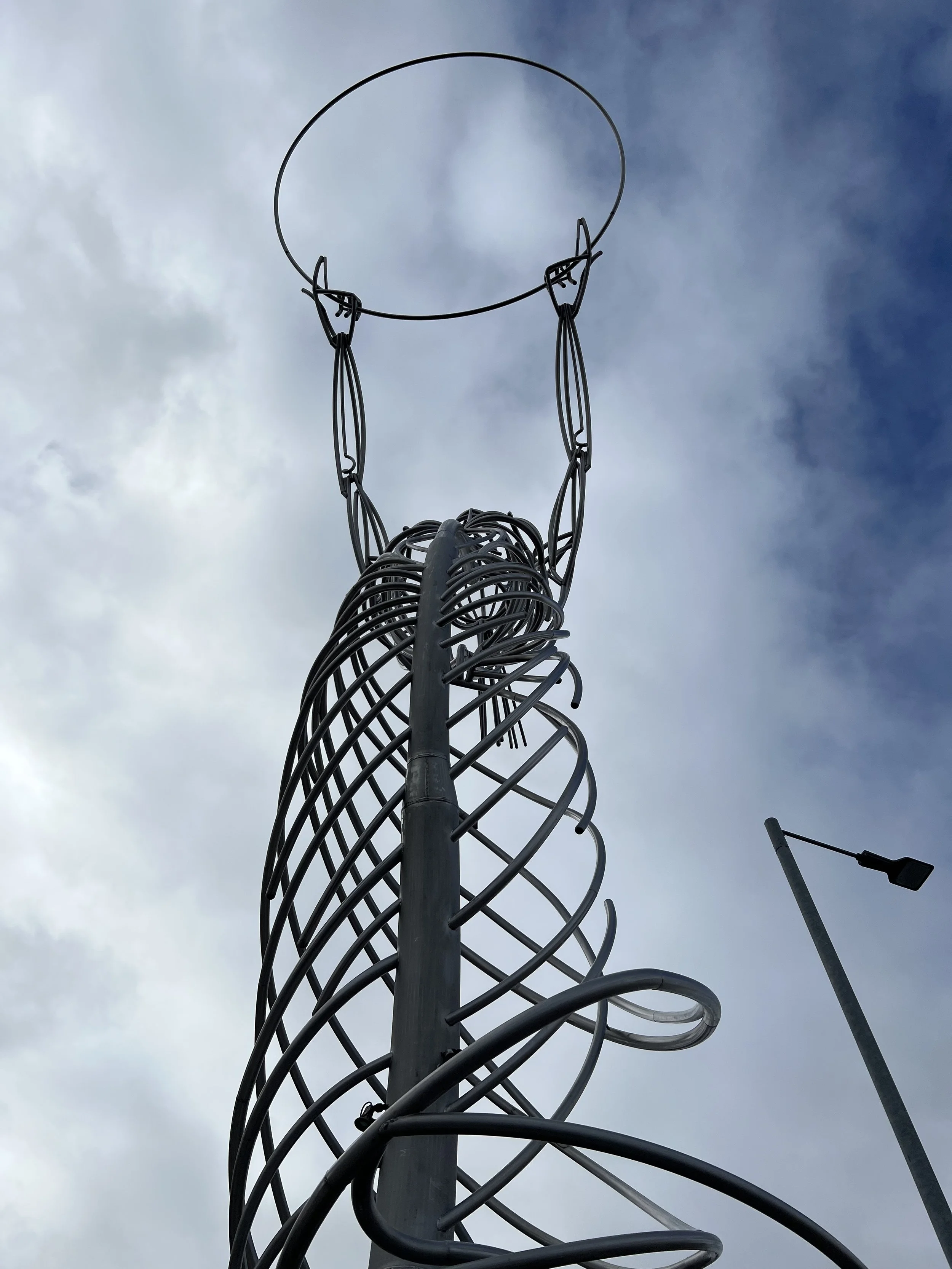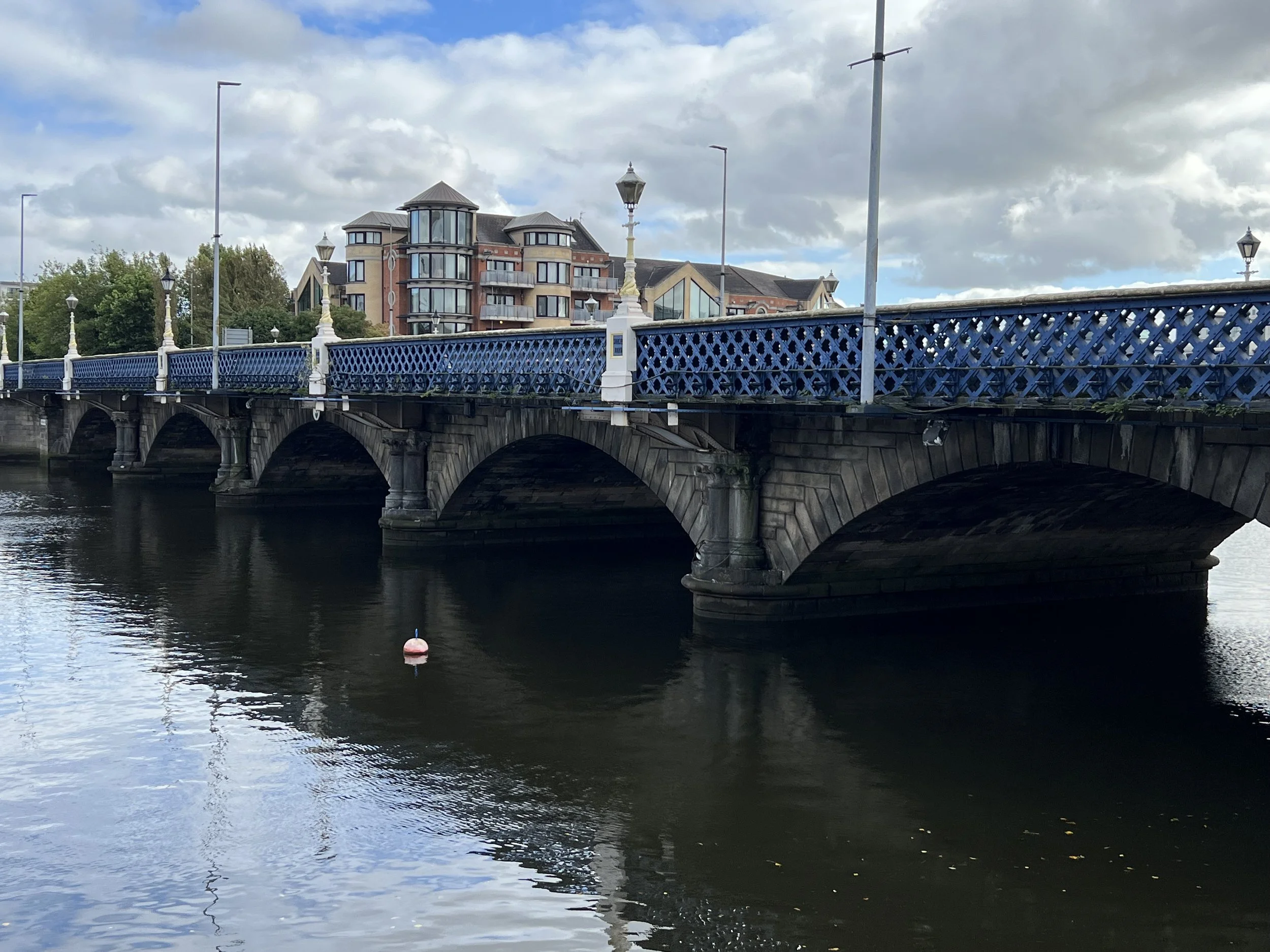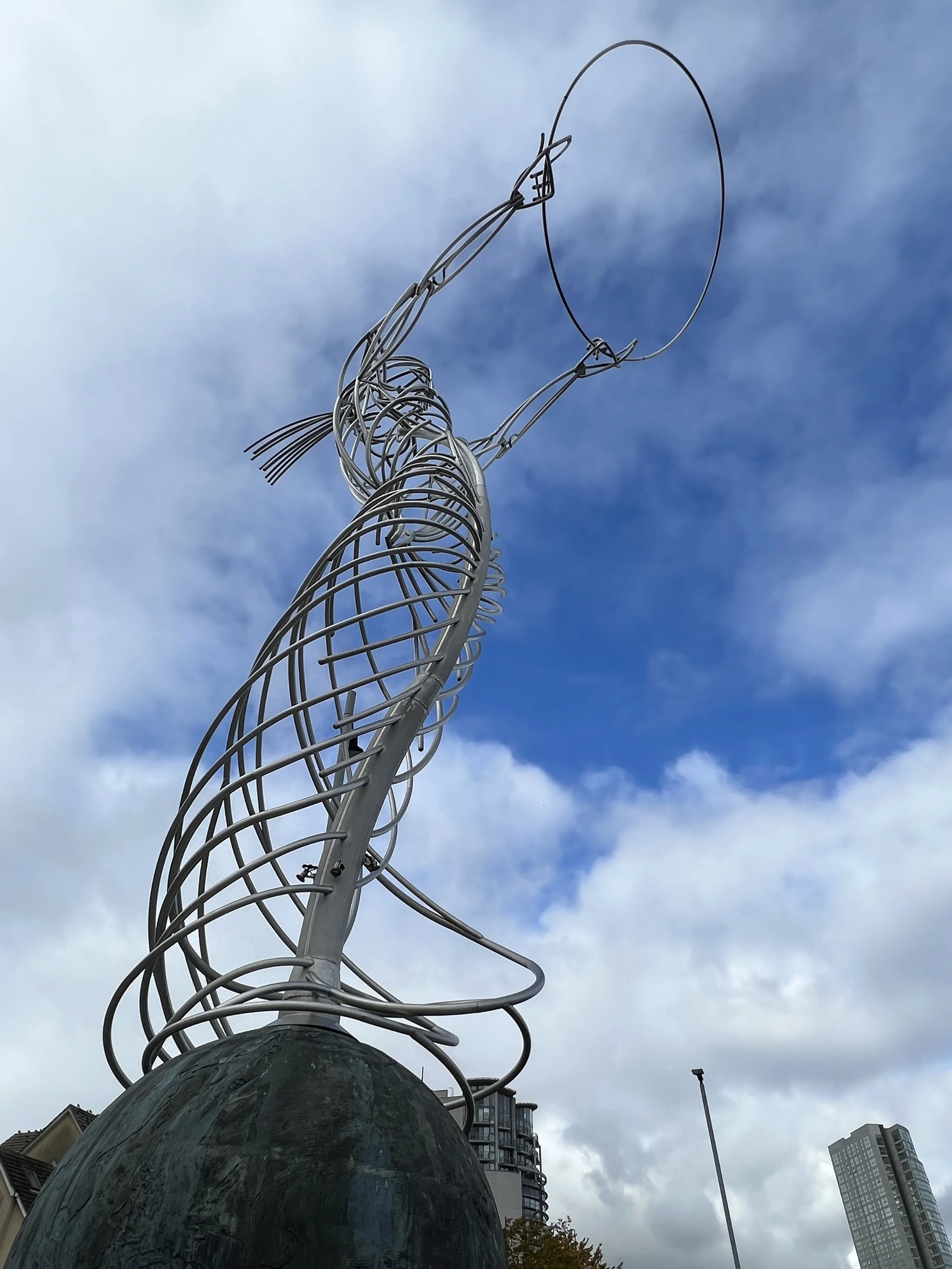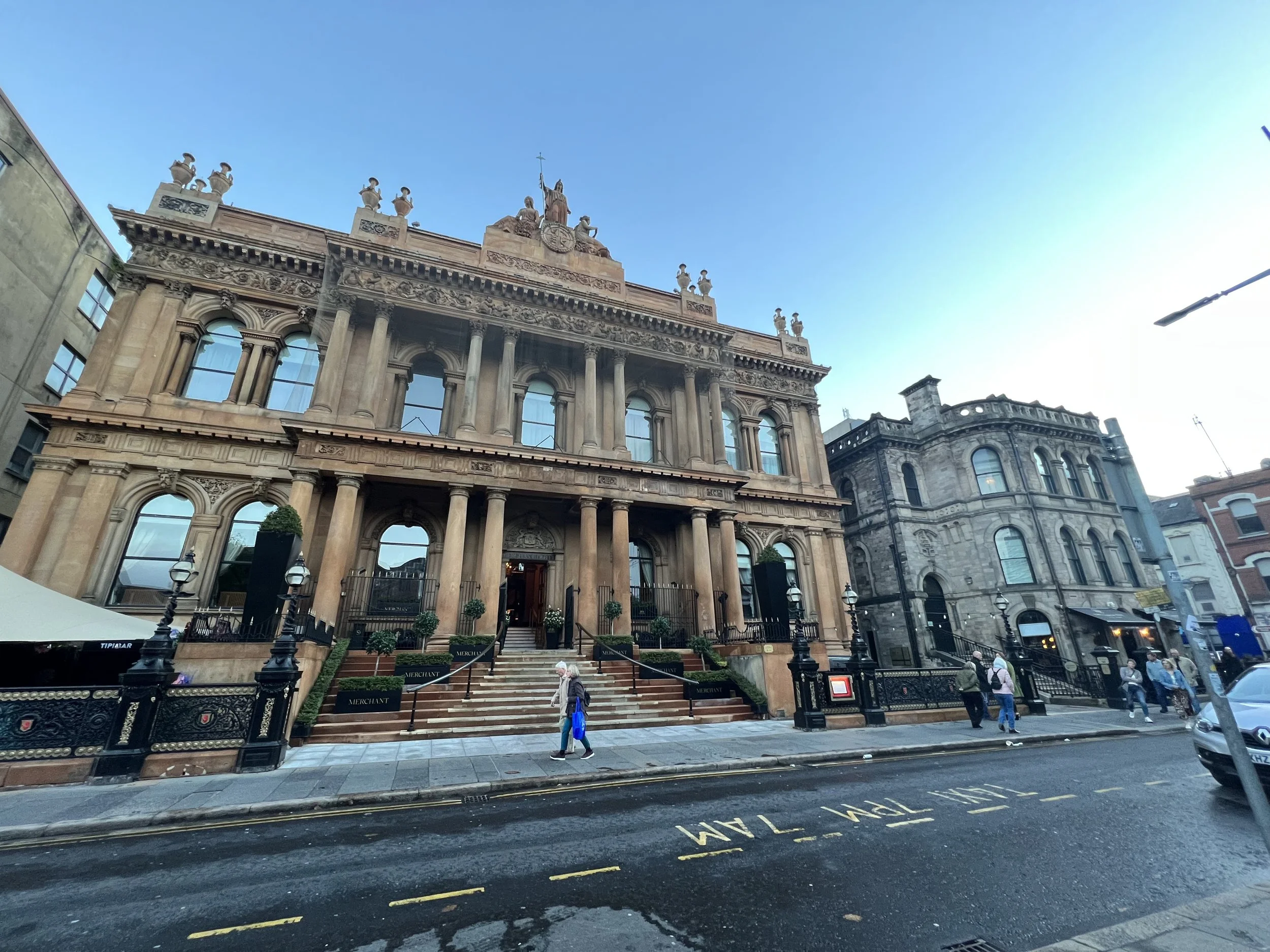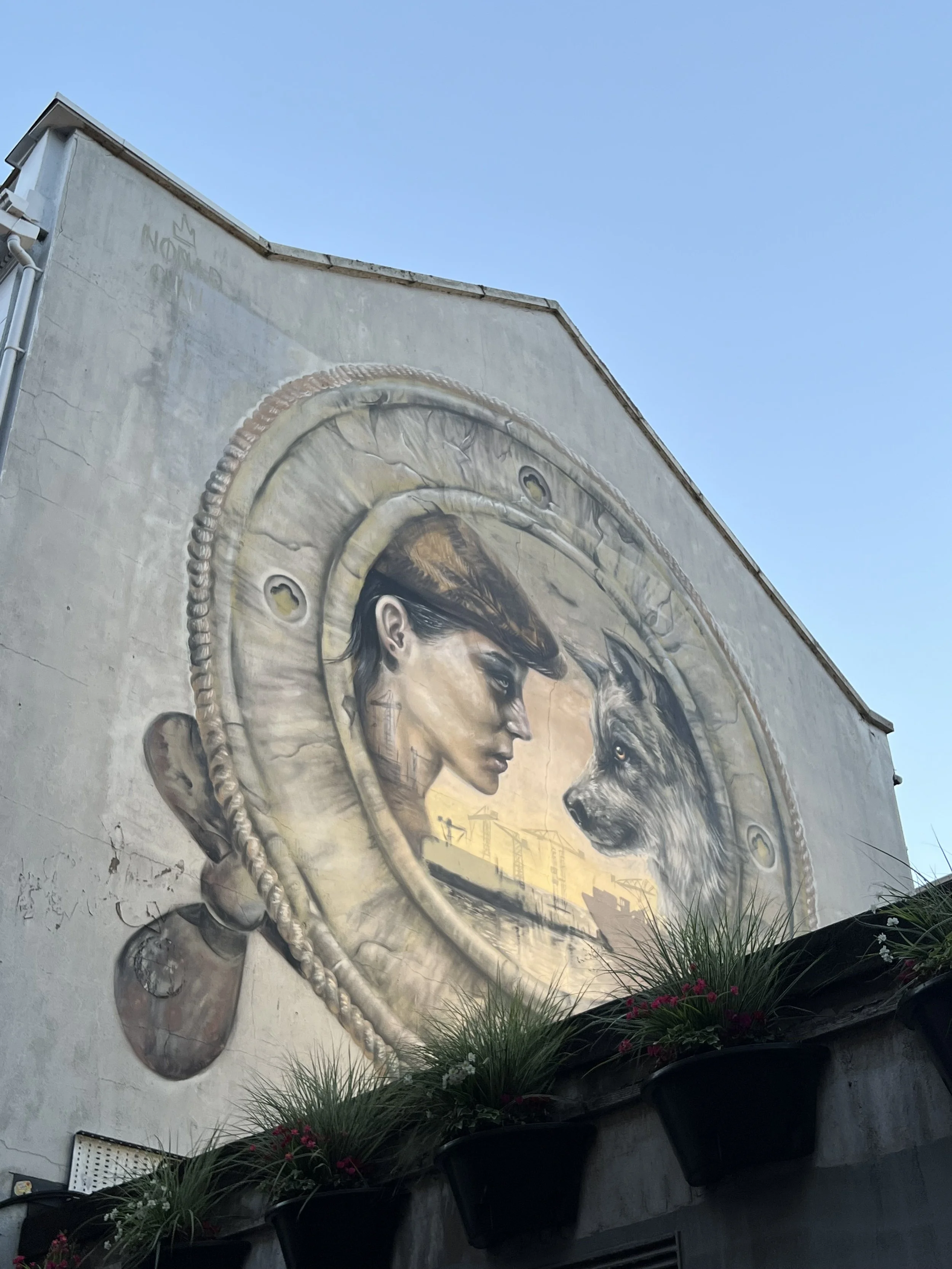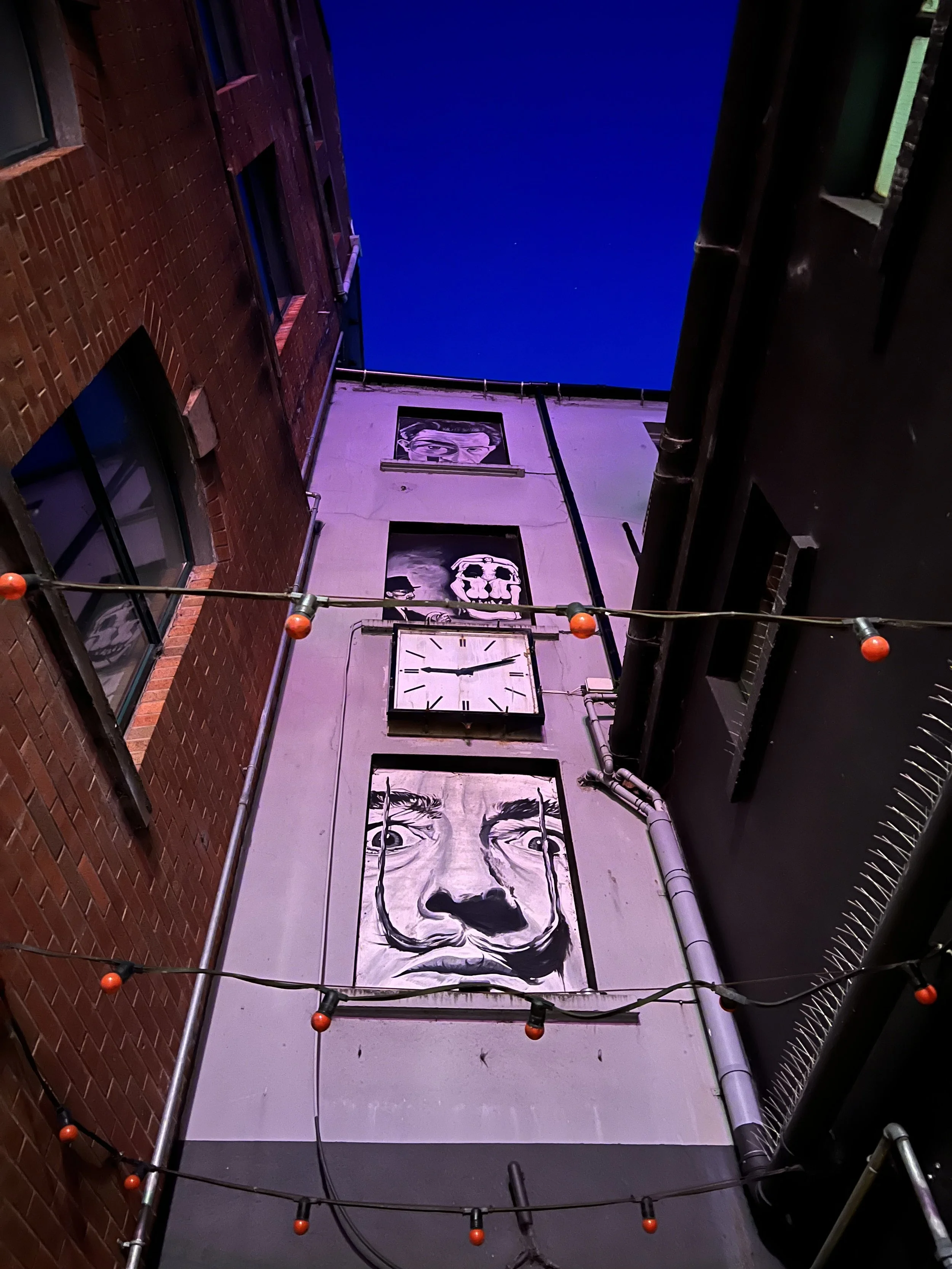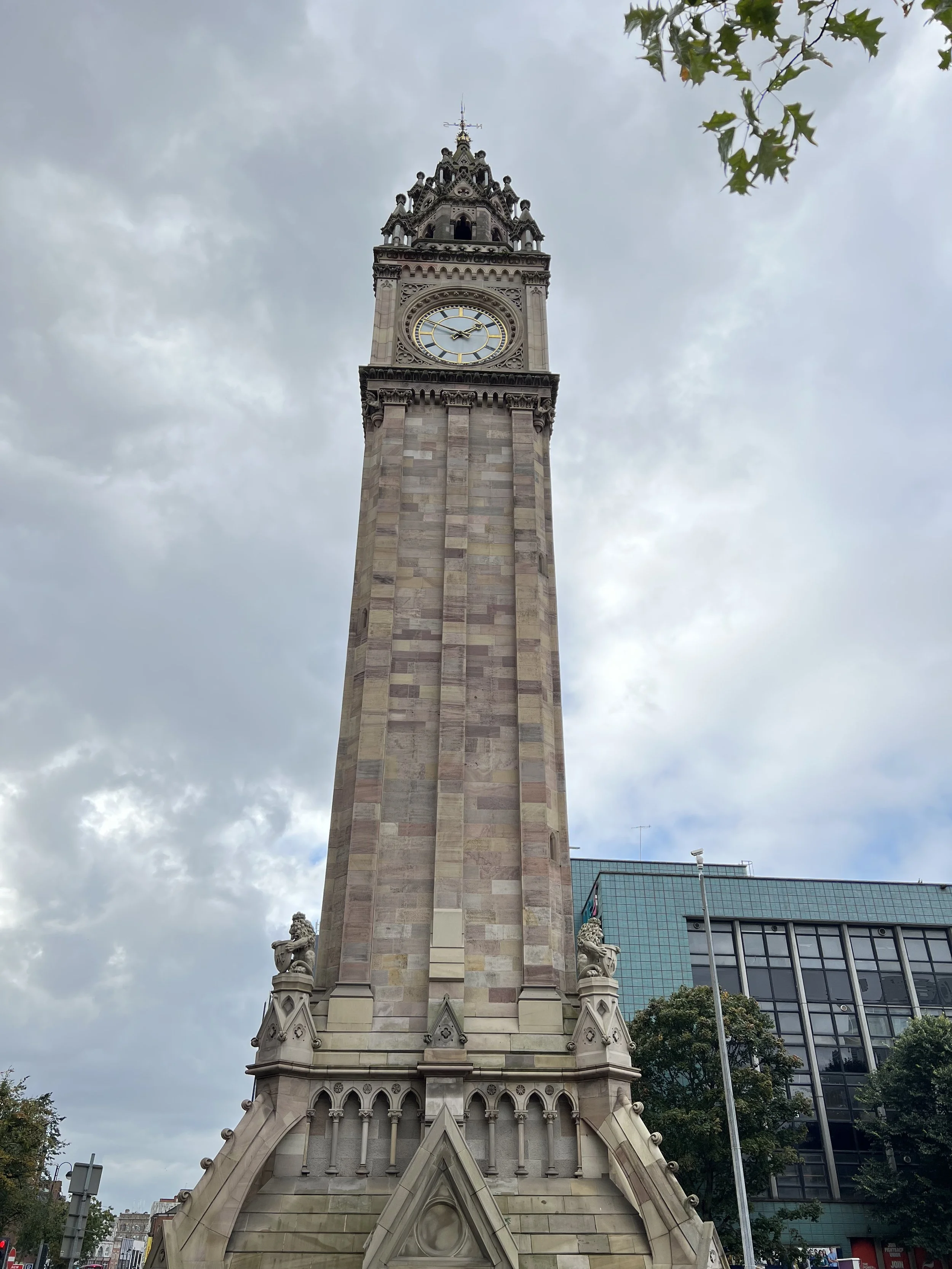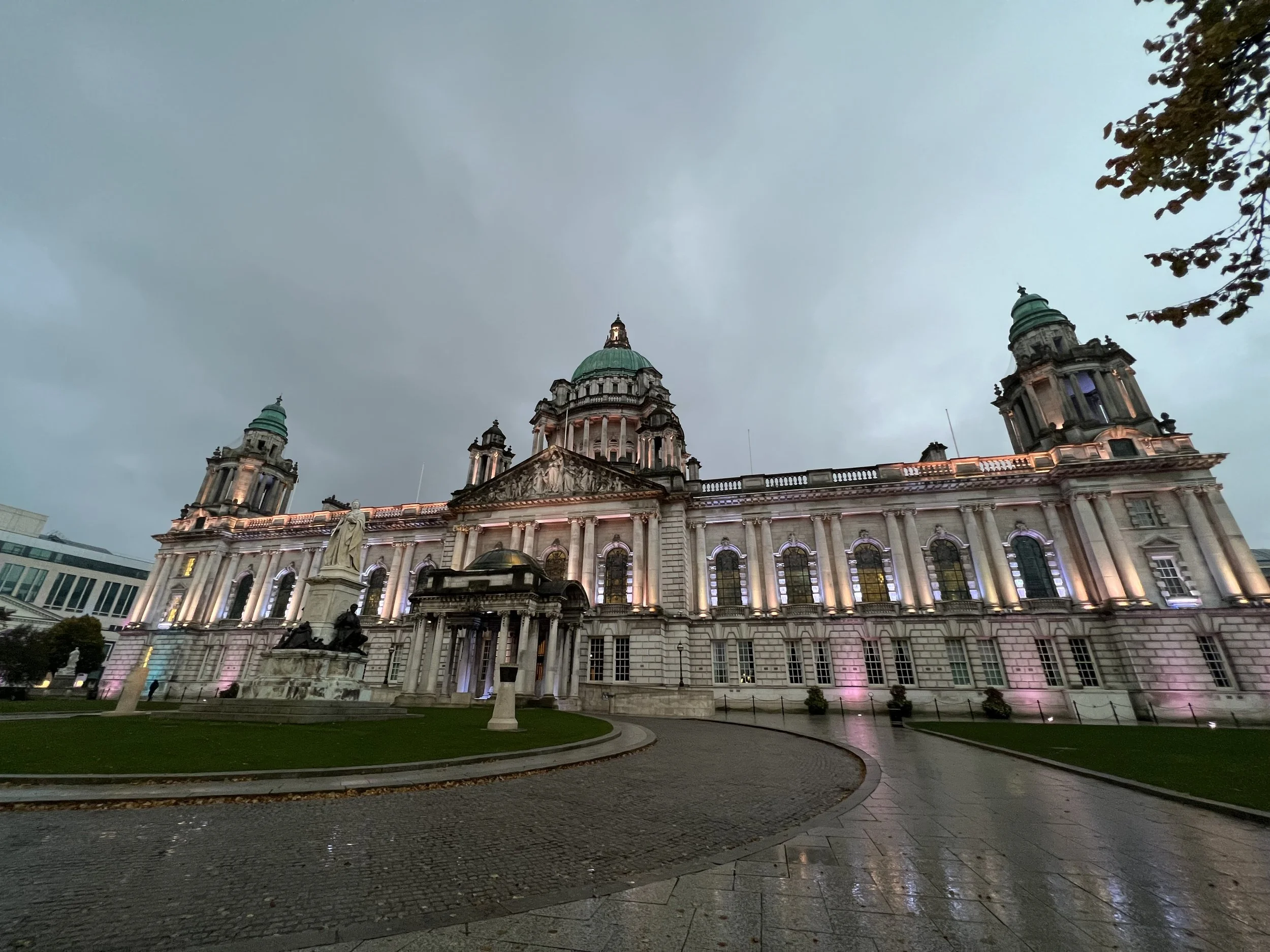Exploring Belfast & Giant's Causeway, N. Ireland
The “peace” wall that still divides The Protestant and Catholic neighborhoods from one another.
For most that have only heard of Belfast in the news, over the decades, know of the political, albeit more religious, unrest in that city. It’s because of that, that I was hesitant to ever visit it. But, Blackbeard had always wanted to visit it, take the Black Cab tour to learn more about the history of the unrest, and as a bonus, show me Giant’s Causeway, so I agreed. I’m really glad I did - it was an amazing city to explore and learn more about (and Giant’s Causeway was breathtaking - literally).
Where to stay
AC Hotel
We stayed at the AC Hotel in a king room, overlooking the Titanic docks and Queen’s Quay - it was phenomenal! The hotel has a great restaurant, is walking distance to everything, and has every comfort someone could want.
Other Great Places to Stay
The Merchant Hotel - Put this at the top of your list if you can - it’s STUNNING!
Where to dine & drink
NOTE: Eating dinner anywhere in Belfast will require reservations a week in advance.
2 Taps Wine Bar
A wonderful Spanish Tapas and wine bar with both indoor and outdoor seating. It’s our top pick!
Bank Square Brasserie
Brick-walled casual dining room with a menu of local produce prepared in creative styles.
Blu
Upmarket destination featuring international cuisine, steaks & desserts, plus brunches.
Darcy’s
Down-home eatery with a local menu featuring fish, meat & vegetarian dishes, plus wine & cocktails.
Duke of York
The Duke of York is an alleyway filled with historical pubs, art installations, and even a hidden museum. The pub with its namesake was 200 years old, though flattened in 1972 when a bomb accidentally went off. Willie Jack bought it in the 1980s and rebuilt it. A fascinating fact: The historic artifacts you see in the pub were (and are) collected across nine counties of Ulster, by Willie, over the last 30 years (and counting).
Ginger Bistro
Relaxed, light bistro with local artwork offering modern Anglo-European fare, plus pre-theatre menu.
Holohan’s Pantry
Unfussy, family-owned eatery offering traditional & local Irish fare plus patio seating & beers.
Howard Street
Upscale destination offering sophisticated comfort food & craft cocktails in rustic-chic surrounds.
Molly’s Yard
Compact courtyard restaurant in converted Victorian stables, serving modern Irish cuisine.
OX
Creative modern British cooking in a pared-down waterside space with bare-brick whitewashed walls.
The Barking Dog
Elegant, modern restaurant offering innovative gastropub-style menu and tapas, plus a set menu deal.
The Crown Liquor Saloon
Opened by Felix O'Hanlon as The Railway Tavern in 1826, the pub was bought by Michael Flanagan, renamed (The Liquor Saloon) and renovated in 1885 to become one of the greatest gin palaces of its time. The elaborate tiling, stained glass, and woodworking are attributed to the Italian craftsmen whom Flanagan persuaded to work on the pub after hours (they were in Belfast to work on the many new churches being built). Due to their fine craftsmanship, The Crown is still so unbelievably ornate that it would take quite a few visits to see every detail. A burnished primrose yellow, red and gold ceiling, a floor laid in a myriad of mosaic tiles, brocaded walls, ornate mirrors, wooden columns with Corinthian capitals, and feather motifs in gold with painted and etched glass are just some of the details you see on first glass, but there are three notable details that make this so unique:
The long Balmoral Red granite topped altar bar is divided by columns and faced with bright colored tiles and a heated footrest.
Ten differently-shaped cosy and elaborately carved wooden boxes, lettered from A to J. In these snugs you'll find gunmetal plates for striking matches, and an antique bell system, very common in Victorian houses, where servants were employed, which alerted bar staff to your liquid needs. Drinking snugs, according to old records, were not originally built for comfort but to accommodate those people who preferred to drink quietly and unseen.
We ate in the upstairs restaurant, which serves traditional Irish fare. Though, with them knowing of my Celiac, they still managed to cross-contaminate food and I ended up sick :(
The Lantern
Informal place dishing up seasonal bistro fare, including multi-course pre-theatre meals.
The Merchant Hotel
Elegant fine-dining restaurant in a magnificent Victorian room, located in an upscale hotel.
The Muddlers Club
Trendy, industrial-style destination featuring innovative tasting menus, wine pairings & cocktails.
What to see & Do
The train from Dublin to Belfast
day trips
Giants Causeway
If you haven’t taken the Giants Causeway day trip, put that in your list of things to do while in Belfast! Below, I’ve broken out our tour by location. If you’re a GoT fan, you’re going to want to see this!
Carrickfergus was built by John de Courcy (known as ‘the petty king’ until 1204) in 1177 as his headquarters. From its strategic position on a rocky promontory, originally almost surrounded by sea, the castle commanded Carrickfergus Bay (later known as Belfast Lough).
Over the next few centuries of conquers and ownership changes, the castle continued to expand/rebuild and operated as a military fortress until 1928. Now it’s an historic site anyone can visit.
Cue GoT theme song … remember the famous scene where Arya jumped into the harbour to flee the assassination attempt? HBO very cleverly shot this scene as if it was the same filming location, but it has actually been shot in two different countries - N. Ireland and Spain! You get about 30-45 minutes to walk around the village, and stop at the store to get snacks and drinks (which I recommend doing because the lunch spot isn’t great).
Cushendun is a small coastal village in County Antrim, Northern Ireland. It sits off the A2 coast road between Cushendall and Ballycastle. It has a sheltered harbor and lies at the mouth of the River Dun and Glendun - one of the nine Glens of Antrim. In the 2001 Census it had a population of 138 people. If you’re a Game of Thrones fan, the caves will look familiar to you as it's where Melisandre gave birth to the Shadow Assassin.
This beautiful avenue of beech trees was planted by the Stuart family in the eighteenth century. It was intended as a compelling landscape feature to impress visitors as they approached the entrance to their Georgian mansion, Gracehill House (which you will see in the video below). Over 200 years later, while some of the trees have fallen down due to storms, many of the trees remain and are a magnificent sight! If you’re a GoT fan, it took the design crew eight days to transform this road into “Kingsroad” for two seconds of a scene.
Ballintoy - Fullerton Arms Pub
The Fullerton Arms Pub is a mid-way point between all that you see above and The Giant’s Causeway. They’re able to serve a few tour groups at once, though note that the food is pretty awful. I suggest grabbing a drink and enjoying the pub side instead. Note: The owner of the pub is a huge GoT fan! He has a replica of the chair you can sit in and also owns one of the six GoT hand-carved doors from the fallen Dark Hedges trees. The other five are scattered about the Antrim Coast drive.
PRO TIP: Ask for a GoT door passport at the pub bar and get it stamped - each location that has a door will stamp it for you!
Around 50 to 60 million years ago, during the Paleocene Epoch, Antrim was subject to intense volcanic activity when highly fluid molten basalt intruded through chalk beds to form an extensive volcanic plateau. As the lava cooled, contraction occurred. Horizontal contraction fractured in a similar way to drying mud, with the cracks propagating down as the mass cooled, leaving pillar-like structures, which also fractured horizontally into "biscuits". In many cases, the horizontal fracture resulted in a bottom face that is convex, while the upper face of the lower segment is concave, producing what are called "ball and socket" joints. The size of the columns were primarily determined by the speed at which lava cooled.
… and now for the “legend” (which is for more fun than the above): The story goes that the Irish giant, Finn MacCool, was challenged to a fight by the Scottish giant Benandonner. Finn accepted the challenge and built the causeway across the North Channel so that the two could meet. But, Finn hides from Benandonner when he realizes that his foe is much bigger than he is. Finn's wife, Sadhbh, disguises Finn as a baby and tucks him in a cradle. When Benandonner sees the size of the "baby", he reckons that its father, Finn, must be a giant among giants. He flees back to Scotland in fright, destroying the causeway behind him so that Finn would be unable to chase him down.
How did this story come to be? Across the sea are identical basalt columns at Fingal's Cave on the Scottish isle of Staffa, which is where the inspiration came from to create this tale.
Our experience there was cold, wet, and windy as an unusual band of weather came in about 30 minutes before we arrived. There’s one shuttle bus you can take down to the pillars and back, but we chose to brave it, which was super fun. When we were done (and thoroughly soaked), we went to the Giant’s Causeway Inn for a hot drink and a snack until our tour bus could pick us up. NOTE: We were told the visitor’s center is a “tourist trap” - that you’re basically paying $15 USD to stay warm. Also, if you don’t want to walk to the inn, The Nook is a pub on the grounds, though it’s small and gets packed fast.
historical tours
Belfast City Centre Walking Tour
Learn about recent history and political struggles in Belfast during a walking tour of the city center. Meet your guide and set out on a city stroll that includes top landmarks such as the Cathedral Quarter, City Hall, and Ann Street. Hear stories about important events during the period of history known as The Troubles and gain a fresh perspective on Belfast and Northern Ireland.
Europa Hotel
The “most bombed hotel in Europe”, The Europa, was opened in 1971 on the former site of the Great Northern Railway. During The Troubles, most journalists were staying there to cover the events, which ultimately became a target for 36 bombings. While badly damaged, it sold for £4.4M to The Hastings Group in 1993 and was shut down for an £8m refurbishment, reopening in February 1994. In November 1995, U.S. President Bill Clinton and First Lady Hillary Clinton stayed in the hotel, booking 110 rooms at the hotel that first time, then coming back several more times after that. There’s a suite named after them as a result. It is still open and operating today and is worth the visit.
SS NOMADIC
SS Nomadic is a former tender of the White Star Line, launched on April 25, 1911 at Belfast, that is now on display in Belfast's Titanic Quarter. She was built to transfer passengers and mail to and from the ocean liners RMS Olympic and RMS Titanic. She is the only surviving vessel designed by Thomas Andrews, who also helped design those two ocean liners. She is the last White Star Line vessel in existence today.
St. George’s Market
After heavy bombing campaigns during World War II, St. George’s Market (circa 1890s) was used as an emergency mortuary for 255 of the city’s more than 700 victims. Not all of the bodies were able to be identified, so a public funeral was held for the unclaimed remains on April 21, 1941. Separate Catholic and Protestant services were held at the market, and the streets were lined with thousands of people as processions made their way to the respective cemeteries.
The market’s appearance today is due in large part to a multi-million-pound restoration that repaired the brick and stonework in the late 1990s. Many of the bricks were unusually sized and had to be produced in England. The distinctive holly green colors were repainted, and Bangor blue slate was reinstated from past designs.
Today, nearly 250 stalls, many of them generational family businesses, serve locals and tourists alike.
Alec the Goose
Alec the Goose is a sculpture dedicated to a popular goose who used to waddle around the East Belfast in the 1920s. During his short life, the goose was a regular at St. George’s Market, as he belonged to a local poultry vendor.
The beloved bird is depicted with a young female companion because it’s said he used to walk the local schoolchildren to school. Tragically, Alec was hit by a truck one day and died.
The statue was rather poorly received when it was unveiled in 2009. The Markets’ Development Association accused the Department of Social Development of choosing to splurge on the artwork instead of funding social and environmental improvement projects.
The Black Cab Tour
One of the most profound tours you can take in Belfast is the “Black Cab Tour”, and if you’ve read the history summary at the top of this post, you’ll understand why. This city has been rife with religious/political tension for centuries and while progress has been made, you can still feel the “on guard” energy of the people, especially the Catholic neighborhood, which is walled off (they call it the “Peace Wall”) and gated (the gates are locked at nightfall every evening and reopened at dawn every morning). While I could go into more detail about the tour, it’s best left to a guide to tell. It was very unexpected and also very educational.
PRO TIP: Make sure to ask for a neutral tour guide that presents both sides of the history on this feud.
Titanic Shipyard & museum
A BRIEF HISTORY
In 1858, Edward James Harland bought a small shipyard that would eventually become the home of Harland & Wolff. Three years later, he partnered with Gustav Wilhelm Wolf to establish the Harland & Wolff shipbuilding company.
In 1906, the shipyard began going through modernizations for the 1907 announcement by Lord Pirrie and Bruce Ismay (the White Star Line chairman), that they intend to build three new Olympic-class liners - Olympic, Titanic, and Britannic. It cost £100,000 to build the giant 6,000-ton gantry over the new slipways. At the time it was the largest gantry in the world, and dominated the Belfast skyline.
On July 29, 1908, Bruce Ismay and Harold Sanderson (White Star Line) met with Lord Pirrie and other representatives for the shipbuilders, at the Harland & Wolff offices in Belfast. The meeting was to discuss general plans for the new ships, and with the order confirmed two days later, Harland & Wolff had the go-ahead to commence construction. This order employed 15,000 people to work six days a week, making it the economic boom for Belfast.
Just 4 1/2 months later, on December 16, 1908, The Olympic’s keel was laid down.
On March 31, 1909, the Titanic’s keel was laid down - 882 feet and six inches in length, it was longer than the height of the world’s tallest building at the time, and weighed 46,328 tons. This “floating palace’ was to be the first ship with steam baths, a heated swimming pool, electric escalators, and hot and cold water in every cabin. It also had a state-of-the-art gym, squash courts, and a lounge and ballrooms inspired by Versailles.
On April 2, 1912, over 100,000 people lined Belfast Dock to cheer Titanic off. Just 12 days later, at 11:40pm, while steaming south of Newfoundland, Canada, at a speed of 20 knots, the Titanic struck a huge iceberg, fatally wounding its hull. Just three hours later, the last of the ship sunk, taking 1,500, out of 2,240, people with it.
From April 19 - May 25, 1912, testimonies were take, including one from the crew of the Californian, who claimed their ship was some 20 nautical miles (37 km) from the Titanic (which had turned out to be false - they were closer). They said it was too small to be the Titanic, though tried to communicate with the ship, via Morse lamp. They claimed the ship sailed away at 2am. The British Board of Trade cited laxity in protocols, including higher-than-usual speeds of the ship, not having enough lifeboats (which established all the safety rules for maritime ships still used today).
Harland & Wolff had much difficulty after this incident, receiving fewer orders for ships to be built - the last of which were two ferries in 2003.
In 2012, the Titanic Museum opened, and in 2019, the derelict shipyard was saved from bankruptcy when InfraStrata agreed to buy it and its assets for £6 million ($7.3 million). Three years later, the entire area has been restored and makes for a fantastic afternoon of discovery.
OUR EXPERIENCE
The sinking of the Titanic has largely been a fascination of mine for decades. To be able to walk the former shipyard, see remnants of where these gigantic ships were built, and tour the impressive museum, became one of the most important and awe-inspiring things we could do in the city. The museum doesn’t just have artifacts, it also has a ride that takes you on a lifelike journey of what it was like for shipbuilding laborers during that time, and has sweeping views of Belfast (and the old Game of Thrones King’s Landing set) from the top. It is one of the first things you should do when you visit the city.
PRO TIP: You do not have to wait in line to see artifacts - it’s a go-at-your-own pace, so feel free to walk around the lines that naturally formed!
Unique experiences
C.S. Lewis Square
C.S. Lewis Square features over 300 native trees, as well as statues by artist Maurice Harron who was inspired by characters from C.S. Lewis’s The Lion, the Witch, and the Wardrobe.
The square is a public spac,e commemorating the Belfast-born author, C.S. Lewis, whose beloved Chronicles of Narnia series included the title. The sculptures depict both heroic and villainous characters, as well as key props from the book, including Mr. Tumnus, Maugrim, the White Witch, Mr. and Mrs. Beaver, the Stone Table, the Robin, and, overlooking them all, Aslan the Lion.
Game of Thrones TRibutes & Set
As us Game of Thrones fanatics know, much of the filming took place in Northern Ireland (more on that when we get to the Giants Causeway Day Tour in a bit). But, seeing the “Kings Landing” set (from afar), right across from the Titanic Museum (appropriately named “Titanic Studios”), was surreal (while it’s still there and may possibly be used for House of the Dragon, it largely goes unused). In addition, The Tourism Board for Northern Ireland, celebrated 10 years of GoT filming there by installing six glass panes that tell the story of each “house”. Click here to see the map of where to find them all.
FOR A FULL STUDIO TOUR: Click here to reserve.
walking tours
The Queen’s Quay
The Queen’s Quay is a redeveloped intersection of the former shipyard, harbor, and railway station areas, giving people a more upscale place to live. It consists of open areas with art installations, beautiful walkways, luxury flats, entertainment centers, and businesses. It’s still an ongoing project with much construction still happening. However, it provided us several opportunities to leisurely take in the beauty around us.
Wandering the streets
As with all the rest of our travels, my and Blackbeard’s favorite thing to do is just wander around and take in as much of the sights as we can. There are so many incredible murals, buildings, and art all around the city (especially alleyways).
how to get around
Getting around Belfast is super easy as everything is walking distance. However, if you need a ride, rideshares are plentiful there, especially with both Lyft and Uber.
If you’re traveling into Belfast, it offers both an airport and a robust train system - the latter of which we took from Dublin and back. Tickets are inexpensive, even for first class, and it’s well worth it for a few hours!
A HISTORY SUMMARY
Bronze Age - The site of Belfast has been occupied since the Bronze Age.
Iron Age - The Giant's Ring, a 5,000-year-old henge, is located near the city, and the remains of Iron Age hill forts can still be seen in the surrounding hills.
1613 - Belfast remained a small settlement of little importance during the Middle Ages and wasn’t established as a town until 1613 by Sir Arthur Chichester.
1700s - The mainly English and Manx settlers took Anglican communion at Corporation Church on the quay-side end of High Street. But, it was with Scottish Presbyterians that the town was to grow as an industrial port. Together with French Huguenot refugees, they introduced the production of linen, an industry that carried Belfast trade to the Americas. Profits from the trade financed improvements in the town's commercial infrastructure, including the Lagan Canal, new docks and quays, and the construction of the White Linen Hall which together attracted to Belfast the linen trade that had formerly gone through Dublin.
Late 1700s - The religious/political uprisings began, causing much destruction of the pre-Victorian city (though some buildings still remain).
19th century - Rapid industrial growth drew in landless Catholics from outlying rural and western districts, most settling to the west of the town. The plentiful supply of cheap labor helped attract English and Scottish people to Belfast, but it was also a cause of insecurity. Protestant workers who organized to secure their access to jobs and housing gave a new lease of life in the town to the once largely rural Orange Order. This caused Sectarian tensions to heighten, sparking a movement to repeal the Acts of Union and to restore a Parliament in Dublin. This triggered the 1864 and 1886 deadly sectarian riots.
1920–22- As the island of Ireland was partitioned, up to 500 people were killed in disturbances in Belfast, the bloodiest period of strife in the city until the Troubles of the late 1960s, onwards. This was called “The Belfast Progrom”.
1921 - As the greater part of Ireland seceded as the Irish Free State, Belfast became the capital of the six counties remaining as Northern Ireland in the United Kingdom.
1932 - The devolved parliament for the region was housed in new buildings at Stormont on the eastern edge of the city.
1941 - 1942 - Belfast was heavily bombed during WWII. In one raid, German bombers killed around 1,000 people and left tens of thousands homeless. Apart from London, this was the greatest loss of life in a night raid during the Blitz. This would happen again a year later.
Post-WWII - Belfast had a long road ahead to rebuild, including agreeing to borrow money from London as long as they agreed to be a welfare state.
1960s - 1998 - Belfast has been the scene of various episodes of sectarian conflict between its Catholic and Protestant populations. These opposing groups in this conflict are now often termed ‘republican’ and ‘loyalist’ respectively, although they are also loosely referred to as 'nationalist' and 'unionist'. The most recent example of this conflict was known as the Troubles – a civil conflict that raged from the late 1960s to 1998.
1970s - Belfast saw some of the worst of the Troubles in Northern Ireland with rival paramilitary groups formed on both sides. Bombing, assassination, and street violence formed a backdrop to life throughout the Troubles.
August 9-11, 1971 - In the deadliest event, known as the Ballymurphy massacre, members of the Parachute Regiment killed at least nine civilians.
December 1971 - 15 people, including two children, were killed when the Ulster Volunteer Force (UVF) bombed McGurk's Bar - the greatest loss of life in a single incident in Belfast. Loyalist paramilitaries, including the UVF and the Ulster Defence Association (UDA), said that the killings they carried out were in retaliation for the IRA campaign. Most of their victims were Catholics with no links to the Provisional IRA.
July 21, 1972 - The Provisional IRA detonated 22 bombs within the confines of Belfast city center, on what is known as “Bloody Friday”, killing nine people. None of these killings were justified.
1980s - 2001 - Belfast was one of the world's most dangerous cities. In all, over 1,600 people were killed in political violence in the city between 1969 and 2001. In addition. the Europa Hotel suffered 36 bomb attacks becoming known as "the most bombed hotel in the world".
1998 - An enduring physical legacy of the conflict are the extensive "peace lines" (or "peace walls") that continue to separate loyalist from republican districts. Ranging in length from a few hundred meters to over 5 kilometers, the security barriers have increased both in number and in height. They divide communities that account for 14 of the 20 most deprived wards in Northern Ireland.
May 2013 - 2023 - The Northern Ireland Executive committed to the removal of all peace lines by mutual consent. As the target date of 2023 approaches, only a small number have been dismantled.

